
Build my resume
- Build a better resume in minutes
- Resume examples
- 2,000+ examples that work in 2024
- Resume templates
- 184 free templates for all levels
- Cover letters
- Cover letter generator
- It's like magic, we promise
- Cover letter examples
- Free downloads in Word & Docs

List of 50 Hobbies & Interests for Your Resume in 2024
- Hobbies/Interests Examples
- Should Hobbies/Interests Be on a Resume?
- Interests/Hobbies to Avoid
- Adding Hobbies/Interests
- Hobbies/Interests Tips
- Hobbies/Interests FAQs
Imagine: You’re a hiring manager for an athletic clothing brand considering two candidates—both with great resumes . You’re having trouble deciding which of the two to move forward.
During your review, you notice one of the applicants is an avid runner. So, you decide to pick the one you think will be a slightly better cultural fit since the applicant likely aligns with the fitness-related clothing products your brand offers based on their running hobby.
But, why “running hobby” instead of “running interest?” Great question. There is a difference between hobbies and interests. Hobbies are things you actively participate in, whereas interests are your dreams or topics you’re fascinated by. That said, they can both be used effectively on a resume to make your already excellent skill set more personable and relevant.
We’ll dive into interests and hobbies to include on your resume and show you how to list them to gain a leg up in the application process.
Hobbies & Interests Examples for a Resume

Example Resume

Why these hobbies/interests work
- Always choose hobbies and interests for your resume that relate to your field.
- Don’t be afraid to include something cool and credible, like being a Jeopardy contestant.
- Thought-provoking activities like helping troubled youths can effectively display your compassion and adaptability in difficult situations.
Most Common Hobbies & Interests for Resumes in 2024

Knowing the value of hobbies/interests on a resume, you may wonder which ones are the most popular in the US. Here’s a quick overview.
- At the top of the list, 40% of US adults have cooking/baking as a hobby or interest. This is a great one to list on resumes for culinary positions or when working around food. It also shows you can follow instructions precisely.
- Want to show some expert research abilities? Reading is an excellent hobby for resumes when applying to jobs involving scientific research or business analysis, to name a couple.
- Everyone’s interested in their pets. Plus, positions like vet techs or even care-based nursing roles can see directly translatable abilities from individuals who love and cherish their animals.
- Applying to a tech-related role? Video games are a potential hobby/interest you could list. It can also show unique problem-solving abilities for analytical positions.
- Nearly half of all jobs require outdoor work. So whether you’re applying to construction, agriculture, or other similar roles, many outdoor activities will be applicable. For instance, a gardening hobby could be great for an aspiring landscaper.
List of Hobbies & Interests for Your Resume

Here’s an extensive list of hobbies and interests to potentially include on your resume.
Volunteering
What better way to demonstrate you’re a caring, civic-minded person than by including your volunteer efforts on your resume?
People want to work with kind people. Not to mention, many companies now give employees time off each year to volunteer for efforts they care about.
Volunteering ideas
- Fostering animals
- Serving within your religious organization
- Firefighter/ EMT
- Coaching youth sports teams
- Volunteering with organizations that help the homeless
- Assisting at local meetups or hackathons
- Volunteering at an animal shelter
- Working for local committees or organizations in your community (like the Board of Education, for example)
Mentioning how you exercise as one of your interests or hobbies can be a great way to build a quick bond with the person reviewing your resume.
However, saying something like “sports” in your interests section is not worth including. What sport do you play?
Exercise can be anything that gets the heart pumping. If you dance or do karate, those are unique hobbies that you should definitely mention on your resume.
Exercise ideas
- Running (if you run events like 5Ks, say so!)
- Weight lifting
- Dance (salsa? square dancing?)
- Basketball (do you play in a league?)
- Rock climbing
- Skiing/ snowboarding
Most companies would benefit by having a creative person join their company. If you’re looking for a career in marketing or design, that’s especially true.
Even if you’re looking for a job as a programmer or data scientist, creativity can still be an invaluable skill.
Listing “music” is not a particularly unique hobby. Saying you play guitar, however, may catch the employer’s eye.
If you have a portfolio of your work, you should link to it in your resume, too, if you’re really proud of it.
Creative ideas
- Photography
- Comic books
- Classic films
- Instruments (guitar, violin, piano, etc.)
- Interior decorating
- Writing (fiction? slam poetry?)
- Calligraphy
- Stand-up comedy
Puzzles/Games
Much like your artistic endeavors can showcase your creativity to a prospective employer, an interest in strategic games indicates that you can strategize and plan.
We likely sound like a broken record but remember to be specific. Saying “video games” is not going to add value to your resume, whereas “PC gaming” might (do your research on the company to make sure this would be appropriate).
Puzzle/games ideas
- Dungeons and dragons
- Jigsaw puzzles
- Crossword puzzles
Your hobbies or interests don’t have to be (and likely aren’t) confined by neat category distinctions. Just ask yourself whether your passion has the potential to showcase a valuable skill.
For example, in the list below, you’ll see brewing beer as a hobby. As long as the business you’re applying to is a more modern company, this could be appropriate to include. To be a successful brewer, you need to be precise and thorough—both great traits in a prospective employee.
Other ideas
- Learning languages (which/how many languages have you learned?)
- Foodie (talking about local restaurants can be a great way to break the ice in an interview)
- Brewing beer
- Cooking (which cuisine is your specialty?)
- Baking (who doesn’t love the person who bakes for office parties?)
- BBQing (this would grab our attention)
- Social media (if you run a successful social account for a local cause, that can be an invaluable skill)
We know! That’s a lot of examples to look through! You can always list a slew of things you enjoy on your resume outline and narrow it down when you build your actual resume . We’ve also got some simple resume templates from Google Docs with a section just for hobbies and interests.
Remember, your hobbies are supposed to be for your enjoyment. If you don’t think you have any hobbies for your resume that will work, that’s okay, too!
Should Hobbies and Interests Be on a Resume?

Before we dive into the types of hobbies and interests you should add to your resume, we first need to answer the question of whether you should include them at all.
The primary factor in determining whether you should include a hobbies and interests section on your resume is the type of role and company you’re applying to .
While older, more established businesses are less likely to be intrigued by what you do outside of work, modern tech companies or startups will likely be interested in learning about your prospective cultural fit. One great way to demonstrate that on your resume is through your hobbies.

- Entry-level candidates can approach resume writing with a “small but mighty” mindset.
- For example, mentioning that you’re a World Sudoku Championship Competitor for not just one but three years in a row shows dedication and laser-like focus.
- If you’re applying for a web development job, try adding a related side project like apps; alternatively, If you’re playing up your artistic side, talk about your interest in web graphics!
How to know whether you should list hobbies/interests
- Read the job description of the role you’re applying to.
- If the answer is “yes,” that’s a good indication that you should list hobbies and interests.
- Visit the company’s website. Read their “about us” section as well as their employment pages.
When it comes to your resume, not all hobbies and interests are created equal ! For example, some of us here at BeamJobs are expert television show binge-watchers. If there was a binge-watching championship, we think we could win gold.
Still, this is a hobby we would leave off our resumes. It’s not that there’s anything wrong with this hobby; it’s just that it’s neither particularly unique nor noteworthy. Remember— the goal of your hobbies and interests are to help you stand out . If the hobby you include is something the hiring manager has seen hundreds of times, it won’t accomplish what you want it to on your resume.
This means you should be as specific as possible when describing your hobbies or interests. “Sports” is not the same as “captain of co-ed basketball team.”
Here are a few more examples of what we mean:
- Wrong: Cooking
- Right: Cooking Middle Eastern cuisine
- Wrong: Travel
- Right: Backpacking through Europe
- Wrong: Music
- Right: Electric guitar
- Wrong: Volunteering
- Right: Volunteering at local ASPCA
- Wrong: Puzzles
- Right: Expert at Sudoko
Interests and Hobbies to Avoid on a Resume
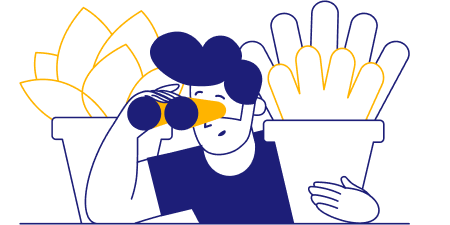
If you’re on the fence about whether you should include a particular interest or hobby on your resume, err on the side of caution . The last thing you want to do is turn a “yes” into a “no” by including something taboo on your resume. This means you shouldn’t list anything about politics on your resume (unless, of course, you’re applying for a job in politics).
This is not to say you should avoid talking about your volunteer experience through your local church if that’s your hobby! Just imagine you’re meeting someone you’d like to make a good impression on. If it’s a topic you’d avoid in that conversation, leave it off if you’d like to present a professional resume . With that said…
BeamJobs’ co-founder, Stephen, knows a thing or two about including a hobby that, under different circumstances, would have been better left off his resume
Before I started BeamJobs with my brother and dove head-first into the world of resumes, I was a data analyst at a company called Chegg.
At that time, one of my biggest hobbies was playing poker. Now, as a data nerd, I took a very data-driven approach to playing poker. I studied the game religiously to develop a deep understanding of winning strategies and probabilities.
Since I was applying for jobs as a data analyst, I thought that would be worth including as an interest on my resume. I also understood poker would likely not be appropriate for all of my job applications .
When it came time to apply to Chegg, I learned that the role I was applying for would be as an early employee for their recently acquired company, Imagine Easy Solutions. I researched the founders and learned they had a history of entrepreneurship.
As such, I included poker as a hobby on my resume. That gamble (poker pun intended) paid off. I learned during my interview that one of my interviewers was a big poker player. This gave me an opportunity to elaborate on my data-driven approach to the game and how I would take a similarly quantitative approach to my job .
We hope this illustrates the potential positive impact of including unique interests or hobbies in your job applications. They help humanize you and give you a potential common interest with your interviewers .
Stephen’s anecdote also highlights two important points:
- Do your research on the company and role you’re applying for; make sure what you’re including as a hobby is relevant.
- Don’t lie. By his own admission, Stephen would have been quickly exposed by a much better poker player in his interview had he told a lie!
How to Add Hobbies and Interests on a Resume

Before we dive into the best way to include hobbies or interests on your resume, let’s start with an example.

- Have outdoor interests like kayaking? These kinds of hobbies can suggest experience in nailing the perfect photography shot and other design strengths.
- Hobbies like fly fishing and comic art can suggest sociability and interconnectedness with others—good soft skills to list on your resume .
- You can use hobbies and interests to express that you’re well-rounded, but the way to really rock this section is by displaying those that directly or indirectly relate to the job you’re after.
Guidelines for adding hobbies/interests to your resume
- Add a specific section to your resume called “Hobbies,” “Interests,” or “Hobbies & Interests.”
- Limit the number of hobbies you include to five at most.
- We have brand-new Google resume templates and Word resume templates that already have this section built in.
- Be as specific as possible.
- Don’t let this section be the reason your resume extends to two pages.
All of these rules follow the principle that your interests/hobbies shouldn’t be the focus of your resume. They’re on your resume to add color. Sadly, some hiring managers won’t put much or any weight on this section of your resume. That’s the reason you shouldn’t make it so prominent.
Unfortunately, you won’t be able to land a job as a surgeon with your hobbies alone—you still need to have the right qualifications for the role! With that said, the more specific you are with your hobbies and interests, the more likely what you list will resonate with the person checking out your AI cover letter and resume .
You also want to be able to relate your hobbies or interests to what makes you a particularly good fit for the role you’re applying to. Let’s look at a few examples.
Job title: Marketer
Hobby: Painting
How it relates: This demonstrates an eye for creativity and design—both important characteristics for a marketer.
Job title: Manager
Hobby: Long-distance runner
How it relates: Committing to improving at long-distance running requires dedication without the ability to see immediate results, which can happen in management as well.
Job title: Software engineer
Hobby: Baking cakes
How it relates: To be an effective baker, you need to be exact with measurements, temperatures, and time but also need a high degree of creativity. To be a strong developer, you must be creative and rigorously logical.
Job title: HR manager
Hobby: Volunteering as an EMT
How it relates: Much like an EMT, to be a good HR manager, you must be caring and empathetic while staying calm in tense situations.
Hobbies and Interests Resume Tips

Most people don’t live to work; they work to live. Therefore, most of your time is likely going to be spent outside of your office.
Including your hobbies and interests on your resume is a great way to humanize yourself and become more than just a resume to the hiring manager.
Tips for adding hobbies and interests to your resume
- Research the company and job description for the role you’re applying for to determine if you should include hobbies.
- Remember: Interests are related to topics you find interesting, while hobbies are activities you participate in and enjoy.
- Keep this section short (four to five interests at most ) and move it to the bottom of your resume.
- Your hobbies are for you—don’t take up a hobby just to please a potential employer.
A hobbies/interests section works great for entry-level candidates who want to include additional relevant abilities or when applying to companies that emphasize workplace culture in the job description. For example, many retail organizations emphasize their culture, so someone applying to be an entry-level retail clerk could benefit from a hobbies/interests section.
A hobby is something you actively do, whereas an interest is something you may be fascinated by or dream about. For example, someone who actively reads an hour per day could consider reading a hobby. On the other hand, someone fascinated by psychology could consider that an interest. You could even combine the two to say you enjoy reading about psychology, which could work great for an aspiring therapist.
Between one to three hobbies/interests works best for most resumes . It typically shouldn’t be the focus of your resume, but moreso act as a way to provide a bit more information or personability to your already excellent skill set.
Either the bottom or the left-hand side margin beneath your education and top skills is the best place for hobbies/interests. This placement leaves room for your work experience, education, and achievements to remain the primary focus of your resume.
Volunteer work is one of the best things to put in a hobbies/interests section when you don’t have work experience since it’s the most similar to a work-related environment. Otherwise, aim for things that are the most relevant to the position. For example, listing a favorite sport or fitness activity, such as rugby or HIIT training, could be great when applying for an entry-level job at a gym.
Related content
- Resignation Letter
- Resume Skills
- ChatGPT Resume
- Resume Format

40+ Hobbies & Interests to Put on a Resume [Updated for 2024]

“Hobbies and interests have no place on the resume.”
Done right, hobbies on a resume can help you stand out from other candidates, show a bit of your personality to the hiring manager, and potentially even get you the job!
That said, not every resume needs hobbies and interests, and at the same time, not every hobby belongs on a resume.
In this article, we’ll teach you everything you need to know about hobbies on a resume, including when to list them, how to pick the right ones to mention, and more!
Here’s what we’re going to cover:
- Should You Mention Hobbies and Interests on Your Resume?
- 12 Best Hobbies and Interests to Put On Your Resume
How to List Hobbies and Interests on a Resume
4 tips to keep in mind when listing hobbies and interests, 40 best hobbies and interests to put on your resume [complete list].
Let’s dive in!
Should You Mention Hobbies & Interests on Your Resume?
There’s no straight-up answer to this question as it depends on several factors.
For example, if you’re a professional with many years of experience in your field, you could probably do without a hobbies and interests section on your resume.
As a seasoned professional, you probably have tons of skills, work experience , and certifications to fill your resume with and set yourself apart from the competition.
If adding a “hobbies and interests” section will make your resume spill over to page two , then you should definitely leave it out.
On the other hand, if you’re a recent graduate with little work experience, adding your hobbies and interests to your resume can help you stand out as a candidate, as well as help fill up your resume to take up an entire page.
But enough with the hypotheticals! Let us tell you exactly when to mention hobbies and interests on your resume and how they can benefit your job application.
What’s the Difference Between Hobbies and Interests?
First things first - what are hobbies and interests?
These two terms are often used interchangeably, but they’re not exactly the same thing:
- Interests are topics, ideas, or subjects that interest you, fascinate you, and you want to learn more about. Culinary art, history, and classical music are all examples of various interests.
- Hobbies are activities you actually engage in. Some examples of hobbies may include cooking, playing basketball, or visiting museums.
Hobbies show the hiring manager how you spend your free time and what kind of additional skills you may possess. For example, if you include “basketball” as your hobby, you’re also telling the hiring manager that you have great teamwork skills.
Interests , on the other hand, indicate what topics and ideas you’re currently interested in or you’d like to explore in the future. If, for example, you’re applying for a job that requires relocation and you list traveling as your interest, you may seem like a more relevant candidate because you enjoy traveling to new places.
So, as you can see, hobbies and interests can add value to your resume if they’re relevant to the job and if they point to soft skills the company may be looking for.
Which leads us to the million-dollar question: when exactly should you include hobbies and interests on your resume?
When to Include Hobbies and Interests on Your Resume
You should include hobbies and interests on your resume when:
- You still have space after including all the essential resume sections (contact information, work experience, education, and skills).
- You have limited work experience, education, and skills related to the position you are applying for.
- The company puts emphasis on its employees’ personalities and unique traits.
- The company specifically asks to list additional hobbies and interests.
- Your hobbies and interests show that you’re good at your job. E.g. if you’re applying for a writing role, having Dungeons & Dragons as an interest might help (as it shows that you’re creative).
New to resume-making? Give our resumes 101 video a watch before diving into the article!
12 Top Hobbies and Interests to Put On Your Resume
So here’s the takeaway: for hobbies and interests to add value to your resume, they should be somewhat relevant to the job you’re applying for.
In most cases, though, candidates list pastime activities that say nothing to the hiring manager reading their resume, like watching movies or listening to music.
To help you avoid such a mistake, we’ve listed some of the best hobbies and interests to put on your resume, based on companies’ most commonly required skills and abilities:
#1. Community Involvement
Volunteering and community involvement is probably the best hobby/interest you could be adding to your resume, as it’s associated with 27% higher odds of employment .
In a nutshell, volunteering shows initiative, empathy, and the ability to see beyond your personal interests. On top of this, volunteering teaches organizational skills, teamwork, and leadership.
#2. Writing
Communication skills - both verbal and written - are some of the most sought-after soft skills by companies .
As such, having writing as a hobby can effectively show potential employers that your communication skills extend beyond the workplace and are, as such, stronger than other candidates.
#3. Blogging
Blogging is another hobby that proves you’ve got excellent communication skills, which is essential for most roles.
At the same time, blogging as a hobby also shows that you’re a self-starter that can work on independent projects, which is another very in-demand skill for most roles.
#4. Learning Languages
It’s no secret that speaking foreign languages can improve your chances of getting a job .
For starters, employers are always on the lookout for candidates who can communicate with people from different nationalities and can be an asset when dealing with international markets.
On top of that, learning languages is associated with improving valuable skills like problem-solving and dealing with abstract concepts, both of which are desirable employee skills.
Some of the jobs where listing learning languages as a hobby can come in handy include social workers, human resources managers, flight attendants, community health workers, hotel managers, customer service agents, etc.
#5. Photography
Just like all the other hobbies on this list, photography can represent you in more ways than “this candidate likes to take pictures.”
After all, photography takes creativity, interpersonal skills, and even technical skills !
This means that, in addition to all the jobs that require photography skills, there are many other positions out there that could benefit from a candidate who’s into photography.

Traveling may not seem like the best hobby to include on your resume at first sight. After all, it simply involves picking a destination and being a tourist, right?
Well, not exactly.
Someone who loves traveling is also likely to be:
- Curious to learn new things, experience new cultures, and meet new people
- Well- organized and adaptable to new situations and people
- Not afraid to step out of their comfort zone
All of these personality traits make for an adaptable and flexible employee, something that employers appreciate!
Sports - and any kind of physical activity, really - are known to improve brain health and your ability to do everyday activities .
Not only, but sports also help you develop self-discipline, teamwork, leadership, and interpersonal skills .
All of these are essential skills that could help you “adapt” your resume to different kinds of jobs.
#8. Reading
Reading is one of the best hobbies to put on your resume, regardless of what types of books you like to read.
Reading exercises the brain, improves the ability to focus, increases general knowledge, can sharpen your communication skills, and helps relieve stress .
#9. Making Music
Making music not only takes creativity, but also a lot of determination, patience, and endurance. Not to mention, studies show that playing an instrument can also improve your memory and focus .
Showing such qualities can instantly make you more attractive to hiring managers.
Yoga is known to create mental clarity , relieve chronic stress patterns, relax the mind, and sharpen concentration.
And - let’s be honest - who doesn’t want an employee who’s mentally clear, unstressed, and able to concentrate on their work?
To do any kind of art, you need to be creative, which is among the most popular transferable skills companies are looking for in 2022.
According to this Adobe study , creativity has gained the most value in driving salary increases in the past five years. That’s also because creativity is also linked to inventiveness, imagination, and problem-solving abilities.
Dancing is more than just a fun pastime. It improves your cognitive abilities, and collaboration skills (especially if you’re dancing with a partner), and can help you unwind and keep your stress levels low.

Top Soft and Hard Skills Related to Hobbies and Interests On a Resume
And here’s what the hiring manager is likely to read from including the hobbies and interests listed above to your resume in terms of soft and hard skills:

Yep, you heard that right.
There IS a right and wrong way to list hobbies and interests on your resume.
In this section, we’ll teach you all you need to know to make your hobbies and interests section as effective as possible!
#1. Decide whether you need them
The first thing you want to do is decide whether you’d benefit from adding hobbies and interests to your resume. As we already mentioned, hobbies and interests can be a breath of fresh air for your resume, but only in certain circumstances.
If you’re a professional with many years of work experience under your sleeve, your resume can do without a hobbies and interests section.
You already have a lot of professional achievements , relevant skills, and qualifications to make your resume a full one-pager, while adding a hobbies section would mean removing some other critical section from your resume.
On the other hand , if you’re a student with almost no work experience or skills, or if you’re applying to a startup or to a company that puts more emphasis on company culture, then you could definitely benefit from listing your hobbies and interests.
The optimal length for a resume is one page.
If including a hobbies and interests section spills your resume over to the second page, that means that you can probably just skip including the section in the first place.
#2. Research the Company
So, you’ve decided it’s a good idea to include your hobbies and interests on your resume. But, which ones do you actually include?
To make the best possible choice, start by researching the company. See if they have any specific work culture, work retreats, and what qualities would complement your role.
Here’s exactly where you should look:
- The job ad. Read the job ad and identify the type of skills that they’re looking for.
- The company website and any employee profiles you can find there.
- Their social media accounts . Specifically, their LinkedIn, Facebook, or Twitter.
#3. Choose the Right Skills
Once you’ve done this, you should think about how specific skills or requirements may transfer to a hobby or interest and tailor yours to the job accordingly.
You may have dozens of exciting hobbies and interests, but your resume isn’t the right place to list them all. Just to reiterate - you want your hobbies and interests to be as relevant as possible .
So, for example, if the job ad mentions the company’s looking for someone who’s “outgoing” or a “great team player,” then any kind of sport is a good hobby to list on your resume.
Meanwhile, anything that involves you sitting alone and being introverted (e.g. reading or knitting) is not very relevant.
An alternative approach to choosing the right hobbies and interests is to use them to fill your skill gaps.
Let’s say that you’re an entry-level professional and you’re applying for your first job as an illustrator. Chances are, you lack some of the technical skills required for the job, simply due to your lack of professional experience.
In such a case, choosing a hobby that proves you’ve got an eye for design and aesthetics can help your application. Anything art-related, including photography, painting, drawing, etc., will show the hiring manager that you’re passionate about this line of work.
#4. Create a Separate Section (and Push It Down)
By now you should have a clear idea of what hobbies and interests to add to your resume.
The rest is fairly easy.
Simply create a separate section titled “Hobbies and Interests,” and place it at the end of your resume . It’s crucial that this section doesn’t overshadow the more important parts of your resume, like your contact information, work experience, education , or even any volunteer work or internships you’ve completed.

Ultimately, adding a “Hobbies and Interests” section at the end of your resume is a great way to wrap up your resume.
It can help you make an impression that extends beyond the professional aspect and give the recruiter a little extra something to remember you by.
Want to start your resume in a way that will grab the hiring manager’s attention? Learn how to write a resume summary with our guide!
#5. List Up to Four Interests or Hobbies
Last but not least, it’s important to list the right amount of hobbies and interests on your resume.
We recommend listing 4-6 total, at most. Anything less, and your hobbies section will look too empty. Anything more, and it’ll look like you’re just trying to fill in space.
Here are some additional tips you should always remember when you’re creating the “Hobbies and Interests” section of your resume:
#1. Find out what you specifically enjoy about your hobbies
People enjoy hobbies for different reasons.
For example, someone might enjoy photography because they love being outdoors and capturing beautiful landscapes, while someone else might enjoy it because it gives them an opportunity to remember every place they visit or every person they meet.
By identifying exactly what it is that you enjoy about your hobbies, it can be easier to describe them on your resume and talk about them genuinely in case the hiring manager asks about them during the job interview .
#2. Be honest
Just like with everything else on your resume, you should be honest about the hobbies you list.
Meaning, don’t lie about hobbies just because you think they sound cool, and don’t over-exaggerate something that can come back and bite you later on during the interview.
Just because you like to go on walks sometimes, doesn’t mean you’re “passionate about hiking” . Imagine the hiring manager’s also a hiking enthusiast and they ask you about the latest trail you hiked, but the only thing you can mention is how you enjoy taking a one-hour walk around your neighborhood daily to clear your mind.
In such cases, it’s better to be honest and write this:
- Physical exercise: exercising daily for 45 minutes by taking a walk in nature.
Instead of this:
#3. Be specific
The more specific you can be about your hobbies and interests, the higher the chances to stand out from other applicants and make an impression on the hiring manager.
Here’s what we mean by that:
- Learning languages: studying and practicing some of the most-spoken languages in the world, such as Mandarin and French.
#4. Keep these hobbies OUT of your resume
A very thin line separates unique from weird, and you want to make sure not to cross it.
To be on the safe side, avoid listing hobbies and interests that might be considered weird or controversial, such as any of the following:
- Hobbies that signal antisocial behavior or activities.
- Hobbies and interests that could be misinterpreted, even if you meant them as a joke (e.g. partying like there’s no tomorrow).
- Hobbies and interests that reveal personal information such as your political or religious views.
- Hobbies that could be considered violent or dangerous (e.g. lighting things on fire).
- Hobbies and interests with little or no interactivity.
Looking for inspiration?
Here are several hobbies you can include, by category, based on your personality type.
Sports Interest and Hobby Examples

Generally speaking, there are two types of sports you can include on your resume - individual and team-oriented .
Depending on the sport, they either show you work well with others, or that you have the self-discipline and perseverance to work alone (or both!)
Endurance sports (like jogging) show your drive and discipline.
Team sports (like football, basketball, etc.) show that you’re comfortable working with others.
Which one you might want to include depends on you and the job. Here are some sports hobbies you could list that will paint you in a positive light:
- Marathon running
- Mountain climbing
Most of these sports are outside and physical activities. They show that you’re comfortable with working with other people and that you have discipline. Therefore, they’re relevant for most job roles that require you to be communicative and self-driven.
Analytical Thinking Interest and Hobby Examples

What’s a thought hobby?
Anything that points to your creative skills and imagination.
If you’re applying for a job that requires a lot of out-of-the-box thinking, you can list the following hobbies:
- Playing a musical instrument
- Photography
- Blog writing
These all point to your analytical thinking and that you’re a creative person.
Possibly more calm and self-composed, and also that you think before you speak.
These qualities can be relevant depending on the job.
Though, your interest section doesn’t necessarily have to consist only of sports.
Social Interest and Hobby Examples

Social hobbies are a great way to show you directly work well with others. Nowadays, most jobs require you to be in contact with other people, in one way or another
To show you work well with others and you’re adept at communicating, you can include:
- Creating and organizing a book club
- Networking events
- Local meetups
- Volunteering at a charity center
- Public speaking
- Exploring other cultures
- Language classes
Social hobbies are great because you’re going to be interacting with other people in most jobs - so one way or another, they’re going to help. Even more so if the job is in a leadership position.
Unique Interest and Hobby Examples

Do you have a particularly unique hobby that not a lot of people are into?
This can work in your favor and help you stand out, as long as it’s still in the unique area and not in the weird one.
The HR manager shuffling through a stack of resumes can remember your unique hobby and come back to your resume later. Or they could even ask about you during the interview, so be prepared to talk about it.
Some unique hobbies that can speak about your character may include:
- Stand-up comedy
- Calligraphy
How do these hobbies help?
Archery implies you might be a precise and focused person. And yoga shows that you can be calm and don’t lose your cool in stressful situations.
Though, just how effective those hobbies will be in your resume may depend on the job.
But as long as it’s not too weird, a unique hobby can help you get your foot in the door and show that you’re not afraid of being different.
Looking for tips on writing a CV instead of a resume? We've got you covered! Head over to our in-depth guide explaining how to write a CV !
Frequently Asked Questions
Do you still have some questions about hobbies and interests on a resume? Check out the answers below:
1. Should hobbies and interests be on a resume?
If you have the extra space to list them, then yes, you should include hobbies and interests on your resume.
Hobbies and interests can help you stand out from other candidates by shining more light into your personality and can also highlight skills you may have that employers seek, such as creativity, organization, problem-solving, etc.
2. What are some good hobbies and interests to put on my resume?
Some of the best hobbies or interests you can put on your resume are community involvement, writing, blogging, learning languages, photography, traveling, doing sports, reading, and art.
3. What are some hobbies and interests for a student resume?
Some hobbies and interests you can put on your resume as a student include creative writing, blogging, volunteering, learning a new language, and singing and/or playing an instrument.
Key Takeaways
And that’s a wrap on everything you need to know about hobbies and interests on a resume!
Before you go and start applying what you learned to your own resume, let’s go over the main points we covered in this article:
- Hobbies and interests can help shine a light on a candidate’s personality and get them to stand out from other applicants with similar work experience and skills.
- Include hobbies and interests on your resume if you still have space after listing all the essential sections, if you have limited work experience and relevant skills, if the company specifically requires it, or if the company puts emphasis on its employees’ character traits.
- Some of the best hobbies to add to your resume include community service, writing/blogging, learning languages, traveling, doing sports, and reading.
- Before creating a separate section for your hobbies and interests, first make sure that your resume would benefit from them, then research the company, and choose the right skills that could complement your skills and qualifications.
- Four things to remember when you’re compiling your hobbies and interests are, to be honest, be specific, and keep hobbies that may be considered weird or antisocial out of your resume.

To provide a safer experience, the best content and great communication, we use cookies. Learn how we use them for non-authenticated users.
Protect your data
This site uses cookies and related technologies for site operation, and analytics as described in our Privacy Policy . You may choose to consent to our use of these technologies, reject non-essential technologies, or further manage your preferences.
- Resume and Cover Letter
- How to List Hobbies and...
How to List Hobbies and Interests on a Resume (With Examples)
18 min read · Updated on March 27, 2024

Should you add personal interests to your resume?
A resume is a summary of your career that informs a future employer of your professional suitability. Personal interests and hobbies on a resume fall outside that traditional definition, but as employers become more interested in cultural fit, showcasing your personality in a job search is increasingly important.
However, how to include hobbies and interests on a resume is not straightforward. In this post, we consider:
How hobbies and interests are different
The benefits of including hobbies and interests on a resume
When you should include interests on a resume
When you should not include interests on a resume
How to include interests on a resume
Where to include hobbies and interests on a resume
The most common hobbies and interests to put on a resume and why they're relevant
Interests you should avoid including on a resume
What's the difference between hobbies and interests?
Though many use the terms “hobbies” and “interests” interchangeably, there are some subtle differences between the two.
Hobbies . Hobbies are activities you engage in regularly. They tend to be more hands-on activities that people participate in for enjoyment and relaxation. Hobbies require acquiring new skills and tend to need engagement and a time commitment. Examples of hobbies include engaging in a specific sport, writing, and cooking.
Interests . Interests are things - ideas, topics, activities - you're interested in learning more about or engaging in more often. Interests often have a broader focus than hobbies, tend to be more intellectually driven vs. hands-on, and expand your understanding. They also tend to require less of a time commitment, since they can be explored through things like reading or asking questions. Examples of interests include airplanes, filmmaking, and photography.
For some, interests eventually become hobbies. You might also note that a hobby for one person might be an interest for another, and vice versa.
So, on your resume, should you call them hobbies or interests? It depends. If you only have relevant interests, you can call the section “Interests.” The same goes if you only have relevant hobbies - call the section “Hobbies.” However, if you're including both interests and hobbies, refer to the section as “Hobbies and Interests.”
What are the benefits of adding hobbies and interests on a resume?
There are a handful of benefits to adding hobbies and interests on your resume, with several outlined below.
Offers a chance to build rapport. Interests and hobbies on a resume offer the chance to build a rapport with an interviewer during an interview . They may even feel comfortable about revealing some insights into their personal life. This is the ideal scenario – you want to work out what makes them tick, too.
Brings depth to your application. Including your interests and hobbies on a resume brings depth to your application, but only if they're relevant to the role. The best candidates get creative about how they position their hobbies and interests to enhance their career story.
Shows you're more than just your work persona. Including a couple of brief one-liners about your hobbies and interests shows that there's more to you than your work persona. As work-life boundaries blur, people want to collaborate with interesting colleagues.
Highlights hard and soft skills. Hobbies and interests require and enhance soft and hard skills that can be highly relevant to open positions.
Fills gaps. Hobbies and interests on a resume can help to fill in work experience and skills gaps you might have for the job you're seeking.
When should you include hobbies and interests on your resume?
Here are examples of when it might be appropriate to include personal interests on your resume:
Entry-level professional. If you're an early-career professional with minimal work experience, including interests is a great way of outlining your motivations and giving the hiring manager a better idea of who they are employing. Two or three lines of personal interests are expected and will add to the application, but you still need to hint at why they are relevant for the role.
Experienced professional. The decision to include interests is less clean-cut for a more senior applicant. In most cases, you'll likely have plenty of relevant work experience to include on your resume. Still, most careers contain skills that can be developed outside of the workplace. If you genuinely have a hobby or interest that contributes to your effectiveness at work, there is no rule that says you shouldn't include it.
Career changer. If you're changing careers and have limited practical work experience, skills, or education related to the position for which you're applying, adding interests and hobbies could help fill in these gaps.
Interests and hobbies emphasize your abilities. If you happen to have an interest or hobby that indicates you're good at the type of job you're applying for, include them. For example, suppose you're applying for a position that requires a lot of public speaking. In that case, you might include your interest in acting, as it highlights your ability to perform in front of audiences.
It's requested in the job description. As is the case for any request listed in the job posting, if the employer requests for you to include your hobbies and interests, be sure you do!
The organization puts a lot of focus on employee qualities and traits. If you notice on a company's website that they tend to highlight their employees' extracurricular activities and personalities frequently, then adding hobbies or interests on a resume could help you to stand out.
When should you not include interests or hobbies on a resume?
And now, here are the reasons you should not include hobbies and personal interests on a resume:
Lack of space. If you're finding that space is tight on your resume, the Hobbies and Interests section is the first that should be cut. Even the section header can take up valuable space. You should always prioritize your work experience if you have more to say. Remember that you may get a chance to mention your interests during an interview.
Lack of relevance. To reiterate, only include hobbies or interests that are relevant to the job. As much as you might like someone to know you can walk a tightrope like a champ, unless it adds value and is applicable, don't include it.
How to include hobbies and interests on your resume
There are several ground rules in terms of adding interests on a resume. Let's discuss the main ones.
Research the requirements of the role
Before you work out whether you're including relevant interests, make sure that you understand the specifics of the role. Making a link with an interest and an obscure requirement of the job is a great way of showing that you know what you're getting yourself into.
Choose interests that match your workplace skills
Once you have a list of skills that your employer desires, be creative in how you match your hobbies with the role. The hiring manager will be reading a lot of resumes, so don't assume that they will automatically make the connection. Be clear about exactly why you're including your interest.
You never know when you might run into an interviewer who knows more about your hobby than you do. Resist the temptation to exaggerate the level of your participation, or it might become an embarrassing situation that will torpedo your chances of getting the job. Honesty is the best policy in a job search.
You can include hobbies and interests on a resume in one of three places:
In a separate “Hobbies and Interests” section
In your Work Experience section
In your Skills or Competencies section
Hobbies and Interests section
If you choose to include hobbies and interests on your resume, the most obvious place to include them is in a stand-alone “Hobbies and Interests” section. In most instances, this should be the very last section you include on your resume.
Work Experience section
While you might have space for a separate Interests and Hobbies section on a two-page resume, there's also the option of slipping an interest or hobby into bullet points or paragraphs around your work experience. If it fits with the point that you are making, it won't seem out of place.
Include bullets with an intriguing description. Just listing “swimming” or “horticulture” as a personal interest will be ignored. If your interest is relevant to the role, include a brief description that offers more detail to fire the hiring manager's imagination. You don't need to write this in full sentences. Include context and quantify with detail if possible. For example, if you're applying for a team lead or training position, you might include the following:
- Swimming. Won the state U23 200m backstroke title. Trained 100+ juniors at the local club.
Skills or Competencies section
If you have one or two hobbies or interests that relate to a specific skill required for the job or would add value to the role, you could choose to include it in your Skills or Competencies section. For example, if graphic design is a hobby of yours and you're applying for a marketing or communications role, adding graphic design as a competency or skill could prove valuable in such a role.
Hobbies and interests to put on a resume - examples
Now, let's get into the details of the interests to put on a resume that may be worth including and why. In this section, we highlight:
Different categories of hobbies or interests
A brief description of why each category can be relevant
The hard and soft skills related to the category that could add value
Specific hobbies and interests examples that you might include on your resume
In the competitive world of work, countless lessons can be transferred from sporting activities. Whether you are playing in a team or dedicated to individual glory, the drive to win and the experience of losing are two sides of the same coin.
In general, including sports on a resume can speak to the following soft skills:
Self-discipline
Communication
Interpersonal abilities
Collaboration
Determination
Ability to handle stress
Examples of sports hobbies and interests to put on a resume are:
Baseball. Everyone has different roles on any sports team. If one person is not doing their job, then the team is weaker. This is collective responsibility at its most basic.
Swimming. Swimming requires hours of dedication and preparation. Any endurance sport offers ample time to think about other aspects of your life.
Skydiving. Extreme sports indicate a risk-taker who is not afraid to push their limits. Perfect when you're figuring it out as you go along in an innovative industry sector.
Yoga. Any interest that involves looking within and clearing your mind of unwanted distractions should be beneficial. Yoga practitioners are often clear-headed decision-makers.
Fitness. The ability to maintain a regular fitness regime should never be underestimated. There are times when you won't want to hit the gym but you overcome your lethargy, which is also a valuable approach to work.
Outdoor pursuits
Venturing outdoors into an uncertain world means that you often need to react to whatever nature throws your way. There's a reason why company away days are often held in outdoor activity centers. Outdoor adventures can teach us a multitude of lessons.
Some soft skills that those who face the great outdoors might have are:
Problem solving
Critical thinking
Working well under stress
Adventurous
Attention to detail
Safety-conscious
Risk-conscious
Examples of outdoor interests to put on a resume include:
Fishing. Patience is a key requirement for many roles. When the long-anticipated opportunity arrives, you need to reel it in confidently and with skill. The chance may not come again.
Orienteering. Working out and agreeing on a path forward is a common sticking point in many corporate settings. Orienteering teaches communication skills and teamwork.
Horticulture. Spending countless weeks preparing the ground for a flower that may only bloom for a short time requires attention to detail and visionary planning.
Camping. The ability to put the hustle and bustle of everyday life to one side and lose yourself in the great outdoors is incredibly good for your mental health. It also shows you have the ability to take time away to balance your work and personal life.
The dedication and creativity that come with learning a musical instrument or training a singing voice can be put to good use in any workplace. The journey is similar when it comes to mastering a new skill at work. Practice makes perfect.
Soft skills relevant to many positions that are often highlighted by musical ability include:
Of course, the technical skills of playing an instrument or being able to sing would be highly relevant in sectors like theater and filmmaking, as well.
Some music-focused hobbies or interests to put on a resume include:
Songwriting. Even writing an email requires filling a blank space with something meaningful. Songwriters understand how to make other people feel a certain way.
Singing or gigging. Standing in front of a crowd and performing are skills that will be useful at work. You will communicate confidently in any meeting or presentation.
Playing an instrument. The process of mastering an instrument never ends. Perfection has no limits. There's always a more difficult piece to play that you can't quite nail.
Volunteering
Every hiring manager wants to hire a selfless employee who will share duties and help others, even when it isn't specified in their job description. Someone with an interest in volunteering will be naturally inclined to make a difference to those around them.
When you showcase volunteer work on your resume, you're often emphasizing the following soft skills, as well:
Charitability
Originality
Abstract thinking
Community-focus
Examples of volunteer work that candidates might choose to include are:
Charity work. The charity that you choose to support will offer an insight into your character. It may also provide a chance to bond with a hiring manager.
Environmental activism. This is bordering on a controversial topic for some people, so include details about your environmental activities with care. If the company you're applying to is environmentally or green-focused, then you'll likely be safe to include it.
Being a mentor. Mentoring outside the workplace is a fantastic source of positive energy. It will teach a multitude of influencing and people management skills.
Community work. Selflessly helping others is a trait of a valuable team player – so long as you know your limits. Sometimes, you need to be selfish and focus on your tasks.
Many creative dilemmas are solved outside of the workplace environment. Do you have the ability to think through a problem laterally when you're taking a shower or during your commute? Creative interests help the right side of your brain to see things differently.
Those with a hobby or interest that requires creativity often possess the following soft skills in addition to creativity:
Detail-orientation
Some creative interests to put on a resume include:
Painting or drawing. While painting is a leisurely pursuit that has little to do with many careers, are we discounting the observational skills of the perceptive artist?
Photography. An appreciation for how visuals can convey a message to make the required impact is central to marketing and sales-related roles. A picture is worth a thousand words.
Graphic design. As business moves increasingly online (and eventually into the Metaverse), graphic design skills come in handy in many careers.
Blogging. Sharing your thoughts in a blog not only benefits your writing skills. As companies increasingly rely on employee advocacy, you can become a champion for their cause. Written communication skills are also a highly-sought after commodity.
Poetry. Brevity lies at the heart of every successful team. Say what you want to say. Make sure that everyone gets it. Move on. Most workplaces could do with more succinct poets.
No one wants to hire a technophobe who is constantly asking colleagues for advice about how to use the basic functions of Excel. Sharing an interest in technology means that you may be the go-to person to ask when such questions crop up.
When including technology-focused interests, you're not only highlighting hard skills that employers eagerly seek, but soft skills, as well, like:
Openness to change
These are just a few of the technology-focused hobbies you might include on your resume:
Programming. An appreciation of coding and programming languages will soon be required in many non-technical industries. The future is digital. Are you ready?
Trading. Dabbling in stocks or crypto requires a level of risk tolerance that is rarely tested in a career. When you're investing your own money, you'll develop critical thinking skills.
Artificial intelligence. If you are this interested in the future of work, it's likely that you will have countless other fresh perspectives to bring to the workplace.
Online activity
While not every industry is dependent on an online presence, there are many functions where online activity is central to success. Sales, marketing, PR, human resources, and recruiting require employees with solid social media credentials and hard skills.
In addition to the technical skills required for online activities, some of the soft skills include:
Creativity
Communication
Decisiveness
Examples of online activity hobbies include:
Social media. As social media evolves into a second life for so many of us, people who have developed an online audience can bring countless transferable skills to an employer.
E-sports. Split-second decisions in a virtual environment (alongside a team) mirror many jobs. Your job might not be a game, but your brain won't know any different.
Vlogging. Building an audience on YouTube or another similar platform requires creativity to work out what to say and the courage to put it out into the world.
Entertainment
Captivating a crowd has been a prized skill for millennia, and it's highly valued in the modern workplace. The ability to keep a screen of Zoom listeners engaged on an hourly basis is a skill that shouldn't be underestimated. Entertaining a crowd is a superpower.
A few soft skills required for entertainment-related hobbies include:
Confidence
Ability to improvise
Below are a few entertainment-related hobbies and interests to put on a resume:
Acting. While we might try to be true to our authentic selves at work, there are occasions where acting skills are required. The ability to play a part is important to maintain unity.
Comedy. If you have the God-given talent to make someone laugh, making friends and influencing others will come that little bit easier.
Dance. Concentration and physical preparation are required to master a dance routine. Sometimes, you only get one chance to make an impression. Dancers can also perform under pressure.
Miscellaneous hobbies
Some hobbies might not fall neatly into a category, though they still offer fascinating insights into your personality and are worth mentioning.
Language learning. Choosing to learn a foreign language as a hobby is no small undertaking. You need a stellar memory and an organized mind to piece together the puzzle of language. Plus, many employers value bilingual candidates.
Home improvement. Project management is ubiquitous in the workplace. Ensuring that a home improvement project runs smoothly demands many of the same project management skills.
Mindfulness. Slowing down and immersing yourself in mindfulness allows the tumult of worldly thoughts to fall into place. Prepare for success from a mindset of calm emptiness and focus.
Which interests should you avoid adding?
When considering interests to put on a resume, avoid these types:
Illegal ones. Okay, you can laugh, but it's still worth mentioning. An employer might question your judgment if you tell them about your late-night parkour running across the city – avoid anything even remotely illegal.
Religion or politics. As mentioned earlier, even environmental activities can be polarizing. Avoid anything with the potential to cause an argument.
Ones requiring complex explanations. Omit any obscure activities that require a detailed explanation. Keep it simple and make sure that the employer will understand the workplace impact of the hobby.
Including hobbies and interests can add value
Now you know when it's okay to put hobbies and interests on a resume and when it's not. You also have plenty of examples of the types of interests to put on a resume that could help you to stand out and highlight vital soft and hard skills. Given that you likely have many relevant interests to put on your resume that might be worth mentioning, be selective in your choices and creative in how you present them using the guidelines above!
Still wondering if you should include hobbies or interests on your resume? And if you are, are you doing it appropriately? Why not upload your resume for a free review from our resume experts and find out?
This article was originally written by Paul Drury and has been updated by Ronda Suder.
Recommended reading:
What is a Resume? It's Much More Than You Think
How to Decide If You Should Turn Your Hobby into Your Life's Work
How to Check if My Resume is ATS-friendly for Free
Related Articles:
How to Maximize Your Resume Action Words to Wow the Employer
Resume Spelling and Accent Explained
Guide to Writing a Great Resume with No Work Experience
See how your resume stacks up.
Career Advice Newsletter
Our experts gather the best career & resume tips weekly. Delivered weekly, always free.
Thanks! Career advice is on its way.
Share this article:
Let's stay in touch.
Subscribe today to get job tips and career advice that will come in handy.
Your information is secure. Please read our privacy policy for more information.
Listing Hobbies and Interests on a Resume: Examples & How-to
Quick Navigation:
What are hobbies and interests you can list on a resume?
How to list hobbies and interests on a resume, best hobbies and interests for different industries.
Adding relevant hobbies and interests to your resume can show hiring managers that you’re dedicated to your profession. They can also highlight your skills and related experience to make you stand out from other candidates. Learn how to add hobbies and interests to your resumes and the best ones for different industries.
Hobbies and interests on a resume are things you do in your free time that help complete your resume. Usually, you can create a ‘Hobbies and interests’ section towards the end of your resume to show employers what you like to do when you’re not working. Listing hobbies and interests can help hiring managers understand more about you and how you could fit into their company culture.
It can be helpful to list hobbies and interests that relate to the role you’re applying for to show you’re a dedicated professional in your field. For example, if you’re applying for a job as a mechanic, you can list interests like rebuilding classic cars or reading automotive magazines.
Here’s how you can add your hobbies and interests to a resume:
1. First, think about what you do in your free time
Consider anything you enjoy doing when you’re not working, like exercising, reading, cooking or anything else. Most things that you like doing in your free time can be considered hobbies or interests.
2. Second, make a list of all of your hobbies
Write down everything you like doing. Make the list as long as you need to include all of your interests.
3. Third, look at job descriptions
Read different job postings in fields you’re interested in to see what some common responsibilities and skills are. See if any of your hobbies or interests relate to the jobs. Your hobbies could also use some of the skills needed for the job. For example, if you’re applying for a job that listed teamwork as a needed skill, you could list playing a specific sport to showcase your teamwork skills.
4. Next, read resume samples
Find resume examples for the job you want to apply for to see some possible hobbies and interests you could list on your own resume. These examples can give you inspiration for hobbies you have that you hadn’t thought of before. Examples can also show you the best way to add your hobbies.
5. Then, create a ‘Hobbies and Interests’ section on your resume
This section should probably be last on your resume since you want to show all of your experience, skills and education first. When you add your hobbies and interests, it’s best to add three at most, so choose your most relevant ones.
6. Last, be descriptive
When you add your hobbies and interests, be sure to make them specific so hiring managers have a better understanding of them. For example, instead of adding ‘Cooking’ as a hobby, try ‘Passion for French baking.’ Being descriptive helps you be more relatable to the employer.
Not everyone adds hobbies and interests on their resumes, but it can be a useful section to show your personality. Only include a ‘Hobbies and Interests’ section if you have space on your resume.
Here are some of the best hobbies and interests you can list for different industries:
Information technology (IT)
Examples that show IT interests or how you stay current in a continuously changing field:
- Building neural networks
- Active participant in local annual hackathon
- Learning new coding languages
- Volunteer instructor at local high school’s after-school programming class
- Play Sudoku and other number puzzles
Be specific in any programming languages or other IT programs you’re learning in your free time. The IT industry also involves a lot of analytical thinking and problem-solving. Additionally, you may need to collaborate with a group or team.
Examples to highlight your communication or entrepreneurial skills for retail:
- Member of neighborhood softball league since 2015
- Regular volunteer at local clothing and furniture charity
- Create custom sewing patterns as side job
- Active member of chess club
Depending on the type of retail you’re involved in, you may be able to add more specific interests as well. You can also add any hobbies that could showcase your customer service skills, which is another valuable skill needed for retail.
Examples for the healthcare industr y to show your interest in physical health and staying current with the latest medical trends:
- Read monthly psychology and neurology medical journals
- Boston and New York Marathon participant
- Volunteer coordinator at local Red Cross
- Lead cycling class twice a week at fitness center
- Member of group aiming to provide healthcare to underserved communities
Healthcare has a wide variety of jobs available, so mention any other hobbies for your specific field.
Construction
Examples for construction that show your stamina and creative problem-solving skills:
- Create custom tables for additional income, about one per month
- Habitat for Humanity volunteer since 2017
- Avid backpacker and speed hiker
- Practice welding techniques
Some of these hobbies involve working with others, which is also important in construction.
Hospitality
Examples for working in the hospitality industry with a variety of people:
- Traveling and exploring local culture
- Maintain a blog about travel experiences
- Currently learning Portuguese and Italian
- Sailboat enthusiast
- Volunteer at local refugee center
Adding any hobbies that involve teamwork would be helpful for hospitality resumes as well.
Foodservice
Examples for foodservice related to your experience with food, time management and collaboration skills:
- Maintain active food critic blog Interest in variations of curry worldwide
- Participant in local food service kickball league
- Volunteer three times a week at local food bank
Depending on the job you’re seeking in the foodservice industry, there are many other hobbies you could add. A server’s hobbies and interests will likely be different than a sous chef’s hobbies.
How to Include Hobbies on Your Resume in 2024 (With Examples)
Learn when and how to professionally list your hobbies on your resume.

What are Hobbies?
Hobbies are activities that you do frequently and in your spare time. It can be anything from collecting postage stamps to working out to volunteering. The key here is that hobbies are activities you perform regularly -- they are more than an interest. An interest is more passive, it’s something you’re curious about but have yet to pursue.
For example, perhaps you have it on your bucket list to scuba dive. That makes scuba diving an interest, because you’re in the research stage. It’s only a hobby if you’ve actually gone scuba diving, and continue to do so on a semi-frequent basis.
It’s important to leave interests out since they can be misleading, and since you don’t yet have the skills associated with that interest.
What Hobbies Should I Include on My Resume?
Hobbies are a great way to show a company who you are and what you value. That being said, try to avoid listing potentially touchy hobbies, as you don’t want it used against you in the hiring process.
- Political associations
- Controversial hobbies
- Religious affiliations
- Irrelevant hobbies
If you do have a hobby that fits in one of the above categories, “rebrand” it so that you can still convey your skills. For example, if you coach your church’s basketball team, leave out the religious component and just write that you coach youth sports. Similarly, if you campaign for a political candidate, note that you can rally your organization and fundraising skills to support an individual or mission.
See the infographic below for examples of hobbies to include on your resume.

Beautiful resume templates to land your dream job

How to Include Hobbies on Your Resume
Have you ever thought about listing your hobbies on your resume? While it seems like “scuba diving” or “baking” may have no place on a resume, your hobbies can actually show that you're a strong candidate for the job by revealing hidden skills.
For example, let’s say you’re applying for a writing position and you keep a personal blog in your spare time. Mentioning this hobby on your resume shows your passion for writing -- you do it even when you aren’t at work! -- your ability to manage time, to research, and to keep your creative juices flowing.
Similarly, if you’re applying to work as a waiter and you’re an avid baker, you should add your love of cookies to your resume. It shows employers that you enjoy the food environment and have an understanding of the time and diligence that cooking requires.
But before you start listing everything you’ve ever done on your resume, let’s break down a few do’s and dont’s.

Why Include Hobbies on My Resume?
Hobbies impart some sort of skill, whether it’s implicit or actively learned. They can show a company what you have to offer. Your goal is to list your hobbies in a way that conveys these skills.
In other words, think of your “hobbies” section like a more interesting “skills” section on your resume.
For example, if you enjoy an endurance sport like running, it shows that you have diligence, determination, and patience -- all skills that cannot be taught through any job or educational opportunity. Skills like these are called “soft skills” because they are implicit in your personality.
Soft skills convey your communication and relational abilities. Some soft skills include:
- Adaptability
- Problem-Solving
- Responsibility
- Interpersonal Skills such as conflict resolution, empathy or mentoring
- Time Management
- Leadership
- Attention to Detail
In contrast, if you enjoy a hobby such as designing art using a software like Adobe Illustrator, this is considered a “hard skill.” Hard skills are those that are learned and gained through a degree, certificate, or another form of education. These include trainings and technical knowledge, such as accounting or software acumen or medical expertise.
Examples of hard skills include:
- Technical Writing, such as email blasts, client relations and research
- Computer Skills, including Microsoft Suite
- Analytical Skills such as data analysis
- Marketing Skills like SEO, SEM, CMS
- Presentation Skills
- Management Skills like database management
- Project Management, include softwares that you are familiar with, such as Trello, Spredfast, and Zoho
- Copywriting
- Foreign Languages
- Design Skills, including Adobe Creative Suite, UX design, UI design
- Mobile and Web Development
- Network Security such as encryption algorithms or authentication systems
When to Include Hobbies
Not all resumes should include hobbies, and it depends heavily on the company to which you’re and its culture. For example, if you’re applying to a firm on Wall Street, it’s best to skip the hobby section. But if you’re looking to work for a local mom-and-pop store or for a more artistic company, then jot down a few hobbies.
Let’s break it down a bit more below.
Only include hobbies if they are relevant to the position to which you’re applying. Ask yourself, what skills does this hobby require, and how does it fit with this job?
For example, don’t include “drawing” on your resume if you’re pursuing a managerial position at an accounting firm, since the two have no common denominator. But, if you’re seeking a job as an event planner , a talent for drawing could help show that you are adept at bringing your ideas to life and communicating them to clients.

Company Culture
A lot of companies today are concerned about their image -- they want to be a fun place for employees to work. If you feel that one of your hobbies shows that you “fit” right in, then list it.
For example, if you’re applying to be a blog writer for a magazine, feel free to note that you love watching films. This could open the door for you to write movie review articles, or it may show that you fit right in with the entertainment-focused atmosphere of a magazine like Cosmopolitan or The New Yorker .
The best way to determine if you should list your hobbies on your resume is to research the company beforehand. Read their “about us” section on their website and browse what former employees have to say about their experience on sites like Glassdoor.

Ice-Breaker and Networking
Interviews are pretty awkward, and it’s hard to stand out when the tired interviewee has already seen dozens of hopeful job applicants. Listing an interesting hobby on your resume can make you memorable. The person interviewing you may even enjoy the same hobby, which will help break that awkward interview tension.
Even if you don’t get the job, having a conversation with a company employee about a common interest is a great way to expand your network. They’re more likely to remember you if you happen to reach out in the future about another opening.
What to Do Next
Brainstorm the hobbies that you enjoy and think about the skills they impart. Now, how well do they match the job that you’re applying to? Be sure to only include hobbies that are relevant to the job description or to the company’s culture.
Customize your hobbies on our modern and professional templates . We also have more tools for writing the perfect resume , adding colors to your resume and listing your certifications .
Good luck and happy writing!
Browse more resume templates that fit your role

Get inspired with more resume examples
Read our how-to guides on making your resume perfect, how to list education on a resume in 2024 (with examples & tips).
Not sure what degree to list? If you should include a GPA? It just so happens that there's a variety of ways to effectively list your eduction.
How to Write a Resume Header
Your resume header is the very first thing an employer will see. Not only does it need to contain the correct information, but it needs to stand out as well! In this guide, we will teach you how to write the ideal header for your resume.
How to Write Your Resume in Reverse-Chronological Order
When setting out to write the perfect resume, choosing a format is an important decision. Reverse-chronological resumes are the standard format, so knowing how to craft one is key! This guide will teach you how to write the best reverse chronological resumes.
How to Choose The Correct Resume Format in 2024 (With Examples)
Choosing the best resume format will be the first step you'll need to get right in order to lay the groundwork for your entire resume.
More advice that will accelerate your career path
Top 10 ats-friendly and readable resume fonts in 2024.
There are thousands fonts you can choose from, but how do you know which are the most suitable for your resume?
20+ Key Customer Service Skills to List on Your Resume in 2024 (With Examples)
To land a job in customer service, you need to showcase your best skills to employers. Customer service involves both technical and interpersonal skills. This makes a diverse skillset all the more important! In this guide, we will uncover the best customer service skills to include on a resume. Plus, we will provide you with tips and tricks for formatting.
How to Explain Employment Gaps on a Resume in 2024
Your journey to discovering your career path can be full of twists and turns. Sometimes, life circumstances can result in gaps in your work history. In this guide, we will teach you all about how to include and explain gaps in your employment to keep your resume looking and sounding strong!
15+ Key Healthcare Skills to List on Your Resume in 2024 (With Examples)
Healthcare is a massive and important industry that contains all sorts of professionals. To land a job in healthcare, you must understand what relevant skills employers are searching for. In this guide, we will cover key healthcare skills to include on your resume and why doing so is so important.
Professional resume templates to help land your next dream job.

Facebook • Twitter • Linkedin • Pinterest • Crunchbase

Resume Templates
Resume samples

Create and edit your resume online
Generate compelling resumes with our AI resume builder and secure employment quickly.
Write a cover letter

Cover Letter Examples
Cover Letter Samples

Create and edit your cover letter
Use our user-friendly tool to create the perfect cover letter.
Featured articles
- How to Write a Motivation Letter With Examples
- How to Write a Resume in 2024 That Gets Results
- Teamwork Skills on Your Resume: List and Examples
- What Are the Best Colors for Your Resume?
Latests articles
- Top 5 Tricks to Transform Your LinkedIn Profile With ChatGPT
- Using ChatGPT to Prepare for Interviews: Top Tips and Steps
- How to Create an Effective Cover Letter with ChatGPT
- 10 Jobs in High Demand in 2024: Salaries and Expected Growth

Dive Into Expert Guides to Enhance your Resume

Hobbies and Personal Interests on Your Resume
Should you include them or not?

Whether or not to write a hobbies section on your resume is an ongoing debate for many career advisors. Here you’ll find the pros and cons of a resume personal interest section.
When we first learn how to write a resume , we’re often taught to include some of our hobbies or personal interests but later in life, we find that it seems less professional and are convinced to avoid them at all costs.
So, which is it?
Do we include hobbies on the resume or not?
And if so, which are the best personal interests to put on a resume?
Read on for a guide with expert advice on how to write a personal interests section for your resume and what not to include as well as ideal hobby examples for all types of jobseekers to use to make an effective resume which will stand out from other candidates.
DOs and DON’Ts for resume interests
It is vital to keep in mind that a hiring manager will be reviewing dozens if not hundreds of resumes for possibly just one vacancy and can easily get bored of seeing the same skills and qualifications over and over which is why adding some interests can be of great benefit, as long as you follow the right guidelines.
DO – The first thing that all candidates must do when adding a hobbies section to a resume is to consider at all times that there resume must represent them as a qualified, suitable applicant to the position and company in question. That means it is essential to maintain an idea of the company, sector and role you are applying to.
DON’T – The most important element to avoid throughout a resume including in the personal interest section is lying ! In some cases jobseekers may be tempted to fabricate a little white lie thinking it won’t be found out and can only help the application along.
Our resume experts cannot stress enough the importance of not lying on a resume . It is not worth the risk, even in a less significant area of a resume.
DO – A must-do to ensure your resume gets noticed is to show your ‘you-ness,’ think of something unique that will be memorable but intriguing to the employer, to make him or her want to contact you and have you as part of their team.
DON’T – Another aspect that you must not include on a resume in a hobbies section is anything related to religion, politics or your intimate personal interests . This is a basic rule of thumb for resumes and any professional profiles on social networks or job applications.
DO – The aim of listing hobbies on a resume is to offer a part of your personality that may not shine through in your academic and professional experience but that can allow the prospective employer an insight into who you are as a person , what drives you and in turn let them gauge whether you will fit well in their business or not.
Should you include your hobbies on a resume?
So you know what you should and shouldn’t put in a personal interest section but is it really a good idea to include hobbies on a resume?
Lots of human resource and resume experts may maintain that including a section on your resume detailing your hobbies is perhaps unprofessional or they see personal interests as irrelevant for a job application, however with the world’s business culture evolving so rapidly, it could end up being the positive edge you need to convince a hiring manager to contact you.
Your resume is your first chance at showing a potential employer what you can offer their company and that doesn’t just involve your professional experience and skills but also your expertise on a range of subjects, your passions and what makes you a good candidate for the role they advertise.
If you know you have what it takes to get the job but your experience is limited , you can use your personal hobbies in a way that demonstrate your abilities that make you the appropriate candidate.
The main purpose of including your personal interests in your resume is to stand out from other candidates in the application process, make yourself memorable to the hiring manager and show them a part of your personality that speaks to them as a human being.
This helps the company or hiring manager get to know you better as a person and not just another resume with the skills and qualifications the position requires.
Of course, if you are applying for an executive-level position in a corporate environment it may be more appropriate not to include hobbies in your resume . With each application, the candidate will have to use their own discretion after researching the business culture.
It does depend majorly on the type of job or company that you are applying to and all jobseekers should consider their individual profile before adding personal interests to a resume.
Further along the application process, such as in a job interview or even a cover letter , mentioning hobbies could also be beneficial to your candidacy as discussing personal interests often helps the body to relax and can build confidence to take the tension out of a stressful situation, thus you are able to show a more natural side when answering questions in a job interview.
If you’re still wondering whether or not to include your hobbies on your resume , why not try out an online resume builder to get a clear digital vision of how your resume looks with all the information you need to include and then decide if you want to show a little of your personal side to the prospective employer as an extra – you never know who might share your interests!
How to write a personal interest section on a resume
Having decided to include a section for hobbies on your resume, now you need to know how to write a personal interest section that will land you the interview.
The structure of a hobbies section for a resume is simple as it is not one of the principle areas like the education or work experience sections. It should be a short list or simply a few lines indicating the hobby and a brief descriptive sentence to explain some aspect of the hobby and it’s relevance alluring to the skills you’ve gained or the knowledge it has given you.
The hobbies section should be clearly titled to ensure it is not encompassed with volunteer work , honors and awards or another of the optional resume sections. It could be simply named ‘ Personal Interests ’ or could include other important facts or certificates that you are relevant to your job application under the heading ‘Extracurricular.’
This part of a professional, student or entry-level resume should be the last thing for a hiring manager to see therefore the hobbies section should always be put at the end .
It is essential to remember to list the hobbies that illustrate how your character will harmonize with the company and their work ethic.
After writing this section, review the hobbies you choose to include in your resume to ensure that any meaning construed from them is positive and speaks of you as a strong candidate for the specific role and company you are applying to.
How to find good hobbies to add to a resume
Some personal interests are not appropriate for a professional profile and should not be included in your resume. Follow these steps to find the best hobbies for your resume .
Before getting into how to write a hobbies section on your resume , you must prepare the types of personal interests or pastime activities you will list. The best method for finding good hobbies to add to a resume is by researching the sector, company and role you are applying for.
The following steps will show you how to make a list of the most suitable interests to have on your unique resume :
- Firstly start with the information you have to hand: the vacancy ad and the job description. Find the characteristics that are required or desired for the person specification. Think of your hobbies in terms of the abilities you have learnt and match them with these personality traits.
- Next you should start your standard research of the company in question by taking a look at their website , paying special attention to an ‘about us’ or employee profiles pages . You may find you even share hobbies or passions with one or more of the current staff members.
- Thirdly, check any other webs or social media sites that the company manages to find out how they interact with partners, clients and customers. Take note of their company culture through their online activities and what they choose to share to be inspired to find similar interests.
- Finally, look up the company on third-party websites, news sites, forums, review sites etc. for extra information which could bring something to your application or even for the interview.
Some of the best hobbies to include on a resume are those that help you to develop transferable skills which could be beneficial to your sector or position for example blogging for a marketing firm giving you existing knowledge of social media and internet publicizing or team sports for sales positions proving leadership skills or outgoing characteristics.
Tips for adding your hobbies
For a winning resume with a personal interest section that attracts attention for all the right reasons, take a look at these tips for adding hobbies to a resume .
The following expert advice for including extracurricular interests on your resume will help you make the most out of a hobby section to optimize your resume for the industry and role you are seeking.
- Be honest about your hobbies within reason, do not overshare and do not lie but you can relate your interests to the company or position offered.
- Remember to consider the various skills you will have gained through your freetime activities and include these to show your suitability to the role.
- Choose a few, select hobbies that match the company culture or work ethic.
- Do not be too specific or peculiar as you want to be able to relate to a variety of people.
- Use your hobbies to demonstrate skills that you have mentioned in your resume objective or qualifications summary .
Examples of hobbies and interests to put on a resume
Still struggling to find good hobbies to put in your personal interest section ? Check out these expertly chosen examples .
As mentioned, it is ideal to include a variety of hobbies or interests in your resume if you decide that it is appropriate. The following examples of hobbies are optimized to show certain skills or abilities that will be advantageous to different profiles .
- Individual Sports such as running marathons, swimming, skiing, tennis, training for triathlons etc. are great hobbies to showcase to demonstrate a person and who likes to challenge themselves and has a strong will power.
- Team Sports such as football, basketball, baseball, soccer, hockey, water polo etc. are also good examples of someone who already knows how to work well and communicate in a team, persevere for common goals and possibly possesses effective leadership skills in appropriate cases.
Also, sports are a good addition as they are a clear example of being physically fit which is beneficial if it is necessary for the position or if the company is dedicated to the health or exercise industry.
- Technological hobbies such as video editing, blogging or computing show a clear passion for the IT sector and extracurricular expertise.
- Puzzles or certain game-playing such as crosswords or chess demonstrate an analytical profile with problem solving or strategic planning skills.
- Social hobbies such as mentoring, volunteering or being part of a club establish the candidate as a person with interpersonal or communication skills.
- Interests that involve collecting objects exhibit passion for a product and an acute attention to detail.
Whether you enjoy translating poetry, designing your own clothes or practising an extreme sport, it might be worth including your interests as an extra section on your resume because you never know where it might lead.
This is a great way to end a winning resume but if you’re struggling to get started, you could try using a resume template to get the basic structure and launch yourself from there. Or take a look at some of ResumeCoach ’s guides to writing an effective resume section by section.

Struggling with Resume Writing?
Ease the process with our templates
Ultimate List of 150+ Hobbies and Interests for Your Resume

3 key takeaways:
- The benefits of listing relevant interests and hobbies on your resume
- 150+ categorized examples of hobbies and interests
- How to list hobbies and interests professionally on your resume
As you work through all of the “must-have” sections on your resume, you may find yourself getting to the end and thinking, “Have I given the hiring team any information or insight into my personal interests in my free time and who I am as a person?”
As you work through all of the “must-have” sections on your resume, you may find yourself getting to the end and thinking, “Have I given the hiring team any information or insight into who I am as a person?”
Enter: the “Interests” section of your resume.
How do you add your interests and hobbies for resume details without drawing attention away from the most important details? And what should you even include? Read on for helpful resume tips on all of the above, in addition to 150+ creative hobbies you can use as inspiration throughout your job search.
Is it unprofessional to list hobbies and interests on a resume?
Highlighting hobbies and interests on resumes can help you stand out and demonstrate your personality, creativity, and unique strengths.
Rather than being unprofessional, listing hobbies and interests on a resume can be a way to showcase yourself as a whole person and not just your work experience or education.
And while there may be some cases where listing hobbies and interests on a resume may not be appropriate or relevant, it can help you stand out and showcase your unique qualities and abilities.
As long as the hobbies and interests are presented in a professional, and they're relevant to the job you're applying to, they can be a valuable addition to a resume.
Why you should list hobbies and interests on your resume
People often make mistakes when crafting their resume and leave out important details.
The "Interests" section of your resume is an opportunity to show a potential employer a little bit more about who you are and what you do in your spare time, as they relate to the job description, in a few critical ways:
1. Resume hobbies showcase a multidimensional person
We're more than our work experiences and skills, and including your unique hobbies and interests on your resume can present a more well-rounded idea of who you are as a person.
For example, let's say a hiring manager is making a decision about the last candidate they'll bring in for an interview. They're deciding between two people with the same level of experience and the same skill set—you and another applicant. You've included a few details about your interests. Suddenly, you're a person with a personality and a bit of depth—a small addition that got you to the next round of the hiring process.
2. Resume interests offer culture insight
There are many companies on the lookout for applicants with unique character or personality traits. Listing hobbies and interests on a resume is an easy way for hiring managers, recruiters, and potential employers to get a glimpse into who you are as a person and how well you'll relate to the company's work culture.
3. Hobbies and interests add depth to limited experience
If you're writing a resume with no work experience under your belt, or you've just graduated and are on the lookout for your first role, listing your hobbies and interests can help to fill in the blanks of any limited skills.
If some of these hobbies include community involvement through volunteering or being a part of an association or networking group, they could speak to you being a team player and highlight your leadership skills.
How are hobbies and interests different from each other?
Interests and hobbies are closely related and often used interchangeably, but there is a subtle difference between the two.
Interests refer to the broader range of activities or subjects that you enjoy or find engaging, while hobbies are more specific activities that you pursue for enjoyment or relaxation. And while there is some overlap between interests and hobbies, hobbies tend to be more specific and hands-on, while interests may be more intellectual or broad-based.
Examples of how hobbies and interests for a resume are different
Hobbies tend to be more hands-on activities that someone actively pursues Interests can be more passive engagement with a topic or subject area
Hobbies are often done for relaxation or creative expression Interests are pursued more for intellectual stimulation or expanding one's knowledge
Hobbies require setting aside time specifically to engage in the activity Interests can be satisfied through more flexible or occasional engagement, like reading or attending events
Hobbies produce tangible results like a painting, knitted scarf, or piece of furniture Interests produce more intangible rewards like satisfying curiosity or gaining new perspectives
Hobbies tend to have a process or involve developing skills Interests are more about appreciation and understanding
Benefits of having hobbies and interests
At the end of the day, both interests and hobbies can provide a source of enjoyment and fulfillment outside of work or other obligations. They can also offer opportunities for:
- Personal growth
- Skill development
- Stress relief
- Mental breaks from daily routines and challenges
- An enhanced sense of identity and self-awareness
- Boosting overall well-being
What kind of hobbies should you put on your resume?
The simple answer: include hobbies and interests relevant to the job you're applying for and that show your value .
Here are a few tips on what kind of hobbies and interests to include:
- Look for hobbies and interests that align with the job requirements and highlight your strengths.
- Show a range of interests by including a mix of personal interests that demonstrate different aspects of your personality and skills.
- Think about the company culture and values and choose hobbies and interests that fit with them.
- Be mindful of the hobbies and interests you include and avoid ones that may be controversial or could be perceived as inappropriate.
- While including hobbies and interests can be a great way to stand out and showcase your personality, it's important to keep it concise and relevant.
With these tips in mind, let’s take a look at some of the different types of interests and hobbies that would be suitable for a resume.
Best types of interests and hobbies for a resume
The best hobbies for your resume will ultimately depend on the nature of the role, the organization’s culture, and which types of experiences matter to the position—you should always tailor your resume for every role. But generally speaking, there are certain hobbies and interests that are strong indicators of different skill sets that can strengthen your candidacy.
Here are some great types of interests and hobbies that can often be strong additions to a resume:
Community Involvement
By engaging in community projects or local councils, volunteering, outreach work, supporting local organizations with your time, youth mentorship, (and more!) community involvement shows that you're not just confined to your own professional and personal life but also concerned about the well-being of others around you.
Listing volunteer work, community service, or other meaningful extracurricular activities on your resume can show interpersonal skills like empathy, compassion, and the desire to make a positive impact on the world.
Community involvement can also demonstrate that you're a team player, have leadership potential, and have a strong work ethic. It reflects your ability to engage with diverse groups and collaborate towards common goals—valuable traits in any employee.
Community involvement can add value to your resume by:
- Highlighting management capabilities
- Presenting event coordination skills
- Emphasizing public speaking skills
- Showcasing empathy and social responsibility
- Signaling a cooperative and compassionate team member
Creative pursuits
Creative hobbies like painting, writing, or performing arts not only enrich your personal life but also have a place on your resume if they're relevant to the role you're applying to.
These pursuits often require critical thinking and problem-solving, which are key in many professional settings. They show that you have a strong imagination, an eye for aesthetics, a desire to express yourself in unique ways, the ability to think outside the box.
Creative pursuits can add value to your resume by:
- Underscoring your ideation, innovation, and the application of abstract concepts to real-world scenarios
- Showcasing proficiency in project management
- Highlighting the ability to see tasks through from start to finish
- Showing a dynamic approach to obstacles and
- Demonstrating a passion for originality
Continuing education
Whether you're taking online courses, attending workshops, or pursuing additional certifications, continuing education is a testament to your commitment to professional growth.
It suggests you're a person who is dedicated to enhancing your skills and knowledge on an ongoing basis. It also demonstrates you likely have transferable soft skills like communication, collaboration, and time management—which are valuable across almost every industry.
Continuing education can add value to your resume by:
- Reflecting an investment in your professional development
- Highlighting a readiness to adapt to new information or technology
- Showcasing self-motivation and seriousness about maintaining a competitive edge
- Demonstrating initiative and desire to improve
- Indicating you are likely to be a lifelong learner who will continue to grow and contribute
Professional development
Active participation in professional organizations, attending industry conferences, or even informal study groups related to your profession can be excellent resume additions. These activities signify your genuine interest in staying connected with industry trends and best practices.
If you enjoy professional reading, learning new skills, or taking courses in your free time, it may suggest that you're intellectually curious, motivated, and enjoy expanding your knowledge and understanding of the world. You may also be detail-oriented and have a love for precision and accuracy.
Professional Development can add value to your resume by:
- Underscoring your commitment to your career and willingness to invest time in your own growth
- Highlighting leadership qualities if you've taken on roles within professional organizations
- Demonstrating a proactive approach to your career trajectory
- Showing foresight and a strategic approach to your professional life
Cultural awareness
Involvement in multicultural festivals, language learning, and international travel all speak to your cultural awareness. This is particularly valuable in today's globalized business environment, where understanding and respecting different perspectives is key.
Cultural awareness can improve your interpersonal skills, making you more effective in diverse teams and customer interactions. It can also boost your adaptability and problem-solving ability in unfamiliar situations.
Cultural awareness can add value to your resume by:
- Suggesting you're a global citizen
- Highlighting your ability to navigate and appreciate the complexities of a multicultural workplace
- Indicating strong communication skills
- Showcasing your potential to represent a company in a global market
Technology proficiency
Including hobbies demonstrating your technological proficiency, like coding for personal projects, engaging with maker communities, or even building computers, can make your resume stand out. In a world where technology is integral to most jobs, these skills are highly valuable.
Technological proficiency can add value to your resume by:
- Showing that you're comfortable with modern tools and platforms, which can be crucial for efficiency in many roles
- Suggesting strong problem-solving skills
- Indicating your ability to self-teach—important in rapidly changing fields
- Highlighting your ability to adapt to new technologies—essential for any business looking to stay current
Intellectual challenges
Participating in activities that present intellectual challenges, like chess, strategic games, or problem-solving competitions, can be an excellent addition to your resume because they highlight attributes that are valuable in roles requiring tactical planning and decision-making.
Intellectual challenges can add value to your resume by:
- Indicating a penchant for critical thinking and analytics
- Suggesting you enjoy overcoming complex problems
- Demonstrating an ability to bring innovative solutions to the table
- Inferring you're a strategic thinker with sharp intellect
Create your interests and hobbies section with Teal
Use Teal's AI Resume Builder to create and customize the interests section of your resume.
Add dozens of interests, group them into categories, and choose which ones you want to showcase on your resume as they relate to every unique job you apply to.
Teal gives you ultimate control over the look, feel, and presentation—clear, precise, and compelling.

150+ examples of hobbies and interests to put on your resume
Creating a carefully curated list of your own hobbies and interests and then choosing the ones that align closely with every unique role can help you save time during your job search in the long run.
And while they should always be relevant to the role you're applying to, understanding everything you bring to the table before you get started can give you a significant advantage in tailoring your resume for every job you apply to.
Below are 150+ examples of interests and hobbies for a resume you can pull from or use as inspiration to highlight your transferable skills, add depth and dimension to your resume, and stand out as a qualified, well-rounded candidate.
Artistic interests for a Resume
- Creative activities
- Creative writing
- Flower arranging
- Furniture building
- Furniture restoration
- Illustration
- Photography
- Restoring Furniture
- Woodworking
Writing hobbies for a resume
- Copywriting
- Essay writing
- Fan fiction
- Fiction writing
- Memoir writing
- Poetry writing
- Screenwriting
- Travel writing
Organization hobbies for a resume
- Bullet journaling
- Calendar syncing
- Digital organizing
- DIY projects
- Event planning
- Home organizing
- KonMari method
- Meal planning
- Organizing local meetups
- Personal inventory
Reading hobbies and interest for a resume
- Attending literary events
- Book collecting
- Book reviewing
- Literary analysis
- Reading challenges
- Reading different genres
- Reading for education
- Translating books
Collecting hobbies for a resume
- Action figures
- Comic books
- Record albums
- Sports memorabilia
- Vintage collectibles
Volunteering hobbies for a resume
- Animal rescue
- Community gardening
- Conservation
- Disaster relief
- Elderly support
- Fundraising events
- Habitat for Humanity
- Homelessness support
- International service
- Literacy support
- Teaching assistant
- Youth sports coaching
Marketing interests and hobbies for a resume
- Content creation
- Data analysis
- Reading marketing books
- Social media
- Videography
Music, movies, and performing arts hobbies for a resume
- Composing music
- Playing a musical instrument
- Magic tricks
- Songwriting
- Standup comedy
Finance hobbies and interests for a resume
- Bargain shopping
- Computer programs
- Learning languages
- Participation in investment clubs
- Reading financial news and market reports
- Volunteer work
Sales hobbies for a resume
- Building relationships
- Cold calling
- Networking events
- Persuasion and influencing skills
- Practicing negotiation
- Role-playing games
- Team sports
- Window shopping
Sports and outdoor hobbies for a resume
- Backpacking
- Basketball
- Bodybuilding
- Fantasy football
- Fantasy baseball
- Individual sports
- Martial arts
- Mountain biking
- Mountain climbing
- Rock climbing
- Scuba diving
- Snowboarding
- Whitewater rafting
Technology hobbies and interests for a resume
- 3-D printing
- App building
- Artificial Intelligence
- Computer programming
- Virtual reality
- Web development
Other unique hobbies and interests for a resume
- Building models
- Car restoration
- Community activities
- Cooking classes
- Historic preservation
- Networking groups
- Personal development
- RV traveling
- Sign language
- Stamp collecting
- Vintage shopping
How soft and hard skills relate to hobbies and interests
Hobbies and interests can play a significant role in developing both soft and hard skills.
Soft skills, or interpersonal skills, are the personal qualities that help you work effectively with others, while hard skills are the technical abilities required to perform a specific job.
The relationship between hobbies and interests and soft and hard skills can be quite strong, and many people find that their hobbies and interests have helped them develop the skills they need for success in their careers.
Soft skills
When it comes to resume soft skills , hobbies and interests can provide opportunities to develop and improve them.
For example, if you're passionate about team sports, you might have developed communication, collaboration, and leadership skills.
Or, if you're interested in volunteer work, you may have honed your problem-solving, empathy, and conflict-resolution skills. These skills are essential in the workplace, and they can make a significant difference in your success.
Hard skills
Resume Hard skills can also be developed and enhanced through hobbies and interests.
Many hobbies require technical skills, such as programming, graphic design, or data analysis. These skills can be valuable in a variety of professions, and they can help you stand out from other job applicants. Even if your hobby isn't directly related to your career, the skills you develop can be transferable to other areas of your life.
Ultimately, hobbies and interests can provide a valuable avenue for developing both soft and hard skills. They allow you to explore your passions and interests while developing skills that can benefit you both personally and professionally.
When it comes to your career, showcasing your hobbies and interests on your resume or during an interview can demonstrate your skills and make you a more compelling candidate for the job. So, if you're looking to develop new skills, consider exploring a new hobby or interest that aligns with your career goals.
Customize the skills and interests on your resume
Manage both the "Skills" and "Interests" sections on your resume with a great level of control to tailor your resume for each individual job you apply for.

How to list interests on your resume
1. use space wisely.
" How long should a resume be ?" is a common question among job seekers. If there just isn't room on your resume for listing interests, it's okay to leave them off. Don't adjust your professional resume template's margins and font just to squeeze these in.
Consider putting your unique interests on another piece of professional real estate—your optimized LinkedIn profile's “About” section, for example.
A great way to check your LinkedIn profile for optimization is to download Teal’s Free Chrome Extension , which includes an automated LinkedIn Profile Review . Once you install the extension, just go to your profile page and click on the Teal logo. You’ll see a list of recommendations on optimizing your profile, and you can make updates as needed.
Teal’s Free LinkedIn Profile Review Chrome Extension
2. Keep your hobbies and interests list short yet detailed
Choose three to five activities for your resume, and be specific if you can.
For example, you can list “Active in a year-round indoor pickleball league” instead of “Playing team sports” or “Part of a book group focused on historical fiction” instead of “Reading.”
3. Tailor your list of interests based on the job posting you're applying for
Your collection of cookbooks may be more relevant than your love of true crime podcasts if you're applying for a role at a marketing agency that works with food and beverage brands. Interests related to musical instruments would also not be the most appropriate for that role.
Choosing relevant hobbies and experiences to highlight can reflect positively on you and help establish that you're even more of a fit for the job position you're applying for. The best resume examples always align closely with the target role, including the your interests.
Use Teal's AI Resume Builder to quickly compare the skills and keywords in the job posting to those in your resume. Make sure to add any relevant experience to your customized resume and to your application answers.

4. Stay away from controversial and irrelevant hobbies
It most likely goes without saying, but avoid listing anything that might be considered polarizing. That could include political or religious affiliations—or potentially controversial activities of personal interest like gambling or hunting.
Unless you're applying for a very specific role where those interests are expected, certain activities might harm the perception of you as a candidate and give other applicants an advantage.
Optimizing the "Interests" section on your resume
Since these details aren't as critical to your experiences, skills, and personal summary, the ideal place for your hobbies and interests is at the very bottom of your resume.
Instead of "Hobbies Section," for the actual name of the section, it's best to stick with something general, such as “Interests.” Remember, you don't want to overcrowd your resume, so don't include more than five hobbies.
If you'd like to take the guesswork out of this section, Teal's AI Resume Builder has a built-in "Skills and Interests" section where you can easily add your details.

Final thoughts on resume hobbies and interests
There are plenty of people who will tell you to leave more “personal” details out of your resume, but business is personal.
You shouldn't have to shut down your personality and the unique details that make you who you are just because you're interviewing for a job. In fact, showcasing a few of the things you like to do when you're not working can offer the entire picture of who you are as a candidate.
Using the Teal AI Resume Builder, you can create a master list of interests and hobbies to put on a resume, then customize your content with relevant details for every role—adding value and clarity to your candidacy.
Sign up for Teal for free and craft a resume that showcases your unique personality, interests, and professional achievements.
Frequently Asked Questions
What are interests.
Interests are activities, subjects, or passions that an individual enjoys or finds engaging outside of their work or academic responsibilities. They are things that make you happy or curious.
Interests can be wide-ranging and may include topics such as history, science, literature, or art. They may involve reading, attending lectures or events, or simply learning more about a particular subject. Interests can also include pursuits that involve physical activity, such as sports, exercise, or outdoor recreation.
What are hobbies?
Hobbies are specific activities or pursuits that an individual pursues in their free time for enjoyment or relaxation. Pursuing hobbies can also offer opportunities for learning, growth, and social connection.
Hobbies are typically more focused activities that a person pursues in their free time. Hobbies may involve crafting, playing a musical instrument, gardening, cooking, or other activities that offer a sense of creative expression or relaxation.
How personal should you make your hobbies and interests section?
When including hobbies and interests on a resume, it's important to strike a balance between being personal and professional. You want to share enough information to give potential employers insight into your personality, values, and strengths, but not so much that your resume becomes too personal or oversharing.
To achieve this balance, focus on hobbies and interests that are relevant to the job or that demonstrate skills or qualities that would be valuable in the position. When describing your hobbies and interests, use language that is professional and relevant to the job. Avoid overly personal or casual language, and focus on highlighting the skills or qualities that make you a strong candidate for the position.
You can use Teal to manage all of your personal interests and hobbies for multiple resumes.

Becca Dershowitz
Related articles.

How to Email a Resume to an Employer [Template + Examples]

How to Ask for a Letter of Recommendation (Templates + Examples)
.jpeg)
What is a Resume Builder?

Rezi Review: Ratings & User Feedback

We help you find the career dream.
Study this sample resume and explore the dropdowns below to learn how to craft a quality resume.
Access the full PDF guide to view all sample resumes and detailed advice.
Watch our video on resume-building . In a hurry? Read our Quick Tips .
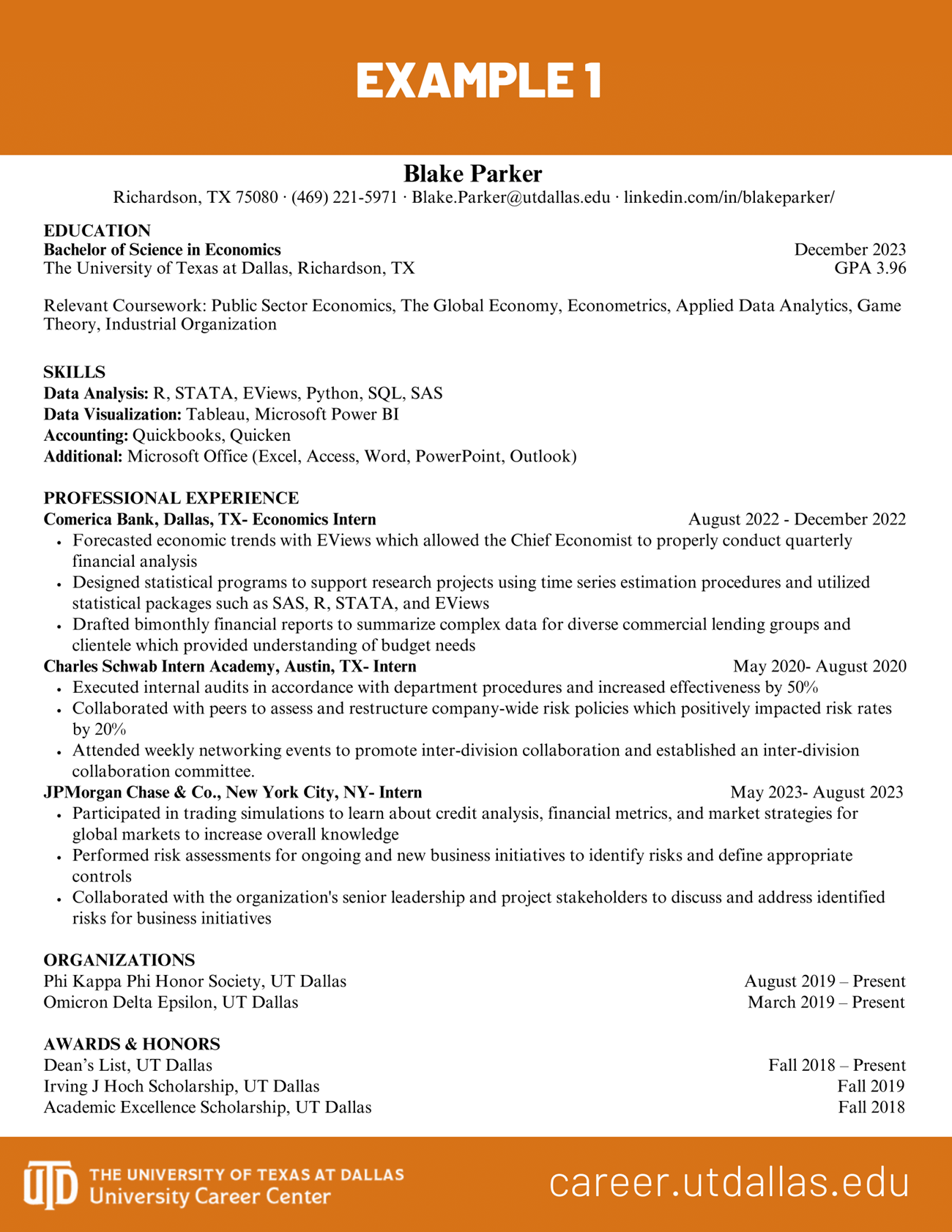
Keep it simple. Name should be 14-18pt font. Contact information should be 11-12pt font. Add links such as Github, LinkedIn, or other professional portfolio sites. Make sure that this section is located at the top of the page. Do not put it in the header section of Word/Google Docs (that is, in the top margin) to ensure readability and Applicant Tracking System (ATS) compliance.
Summary (also called the Profile) is optional. If you choose to include this, make sure that it is highly tailored to the field you are pursuing. Express your goals and value beyond “looking for a summer internship”.
The Summary should be located between your Name & Contact and your Education sections.
Arrange your Degree and University along the left margin and your expected Graduation Date and GPA (if it is above a 3.5) along the right margin. Consider putting your Degree in bold to better highlight your skills and knowledge.
Align on the left margin and make a list or use bullet point formatting to ensure Applicant Tracking System compliance. Only list coursework that clearly demonstrates your value.
Be sure to spell out the title of the class; most people outside of UTD will not recognize the course abbreviation/numbers.
Classify your skills if you have many. Otherwise, start at the left margin and make a list. As long as you can honestly speak to your ability, you can add it to your Skills section. Don’t sell yourself short!
Soft skills (for instance, communication, active listening, customer service) do not go in the Skills section. Rather, work these into your bullet points.
Experiences can be Professional or Academic. In both cases, be sure to build out the sections like you would for a job—clearly demonstrate the skills you used and the results you gained. For Academic Experience, do not simply discuss the end results of the app you built or the topic you wrote a paper about. Keep in mind that you likely will not be hired to create that exact app again, but you will be called upon to use those hard and soft skills again. Sell your skills, not the particular project.
Start with a strong action verb. Try not to repeat the same verb.
Be specific—you want the potential employer to clearly picture your skillsets and work style.
Use a model like WHO ( What you did, How you did it, Outcome /Purpose) to ensure that you are covering all the important information. See our full guide for more examples of the WHO model and for other effective models. Add metrics—quantify where possible.
Add any experiences that you believe will help showcase you as a professional. Athletics or other non-industry organizations can be added; however, be sure to prioritize industry-related content on your resume. Do not add hobbies unless you are affiliated with an organization (for instance, a UTD Baking Club would be all right to list. However, you would not want to list simply “baking”.
Awards can go close to the end of your resume. You can also consider adding scholarships as part of your Education section.
The University of Texas at Dallas
University Career Center
Student Services Building 3.300
800 W. Campbell Road Richardson, Texas 75080-3021
972-883-2943
Privacy Policy
© The University of Texas at Dallas

25 résumé mistakes that could stop you getting your dream job
Posted: 30 August 2023 | Last updated: 30 August 2023

Don't make these mistakes
When it comes to job interviews, we've all heard that first impressions are key. Well, the same goes for your résumé. An eye-tracking study by career site Ladders Inc. found that recruiters spend just seven seconds scanning an application. With such a small amount of time to impress, it's vital to avoid the mistakes that could cost you the chance of getting your dream job. Read on for 25 of the most common.

1. Making it too long

2. Making it too short
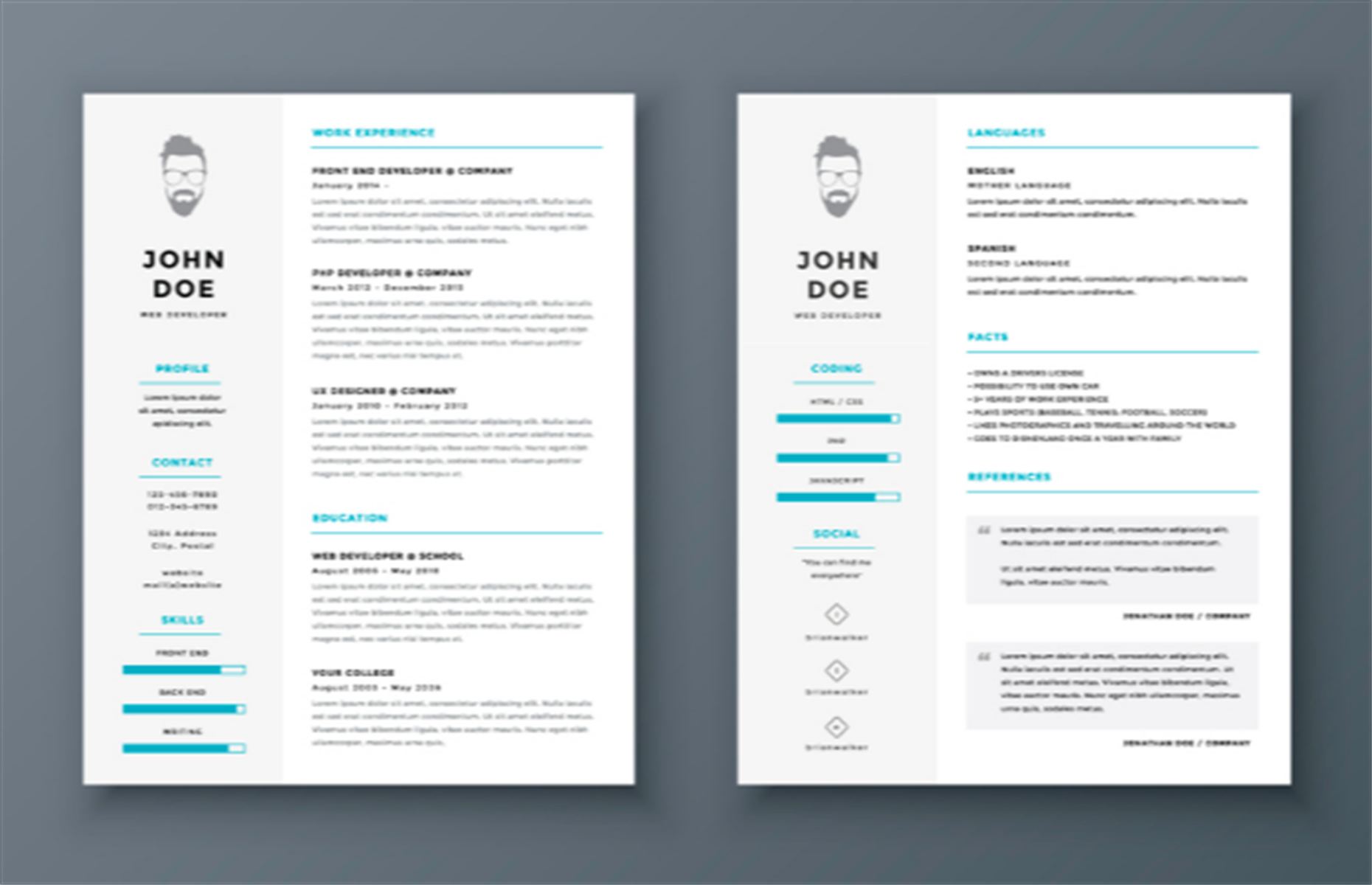
3. Picking the wrong design
It's a good idea to make sure that your résumé is designed in a way that reflects the type of job you're applying for. For example, if you're applying for a position in graphic design or the creative arts, it could work against you if your application is dull and uninspiring. In contrast, if you're applying for roles in industries such as finance or law, it's best to stick to a traditional layout.
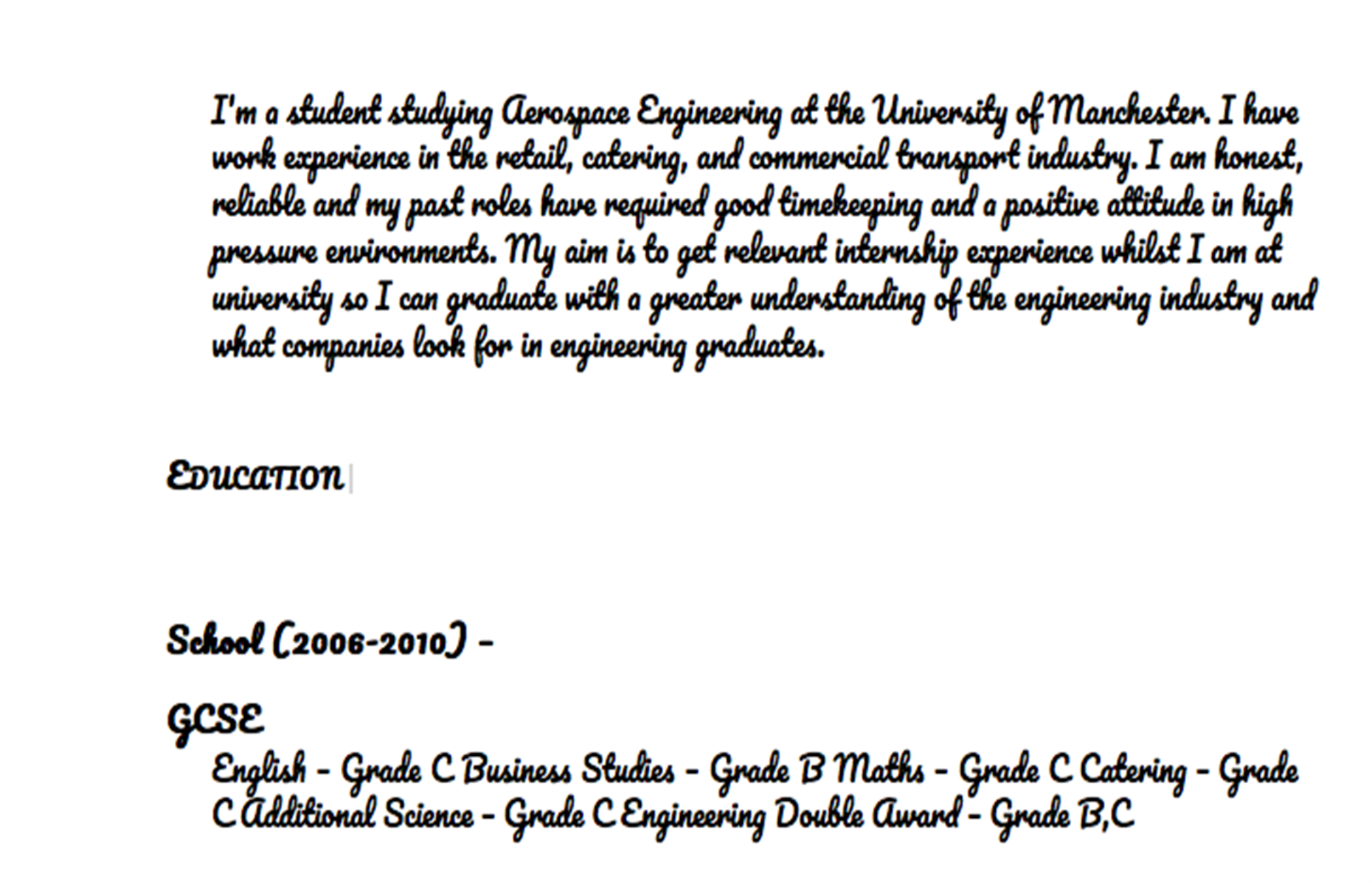
4. Strange font choices

5. Bad formatting

6. Bad use of colour
Adding a splash of colour to your résumé won't hurt if you're applying to jobs in the creative sector or less conventional companies. However, you should be controlled in your use of colour. Only use colours in headings, and avoid garish or hard-to-read colours such as yellow. If you're looking for jobs in more traditional firms such as banks it's a good idea to stick to black and white.
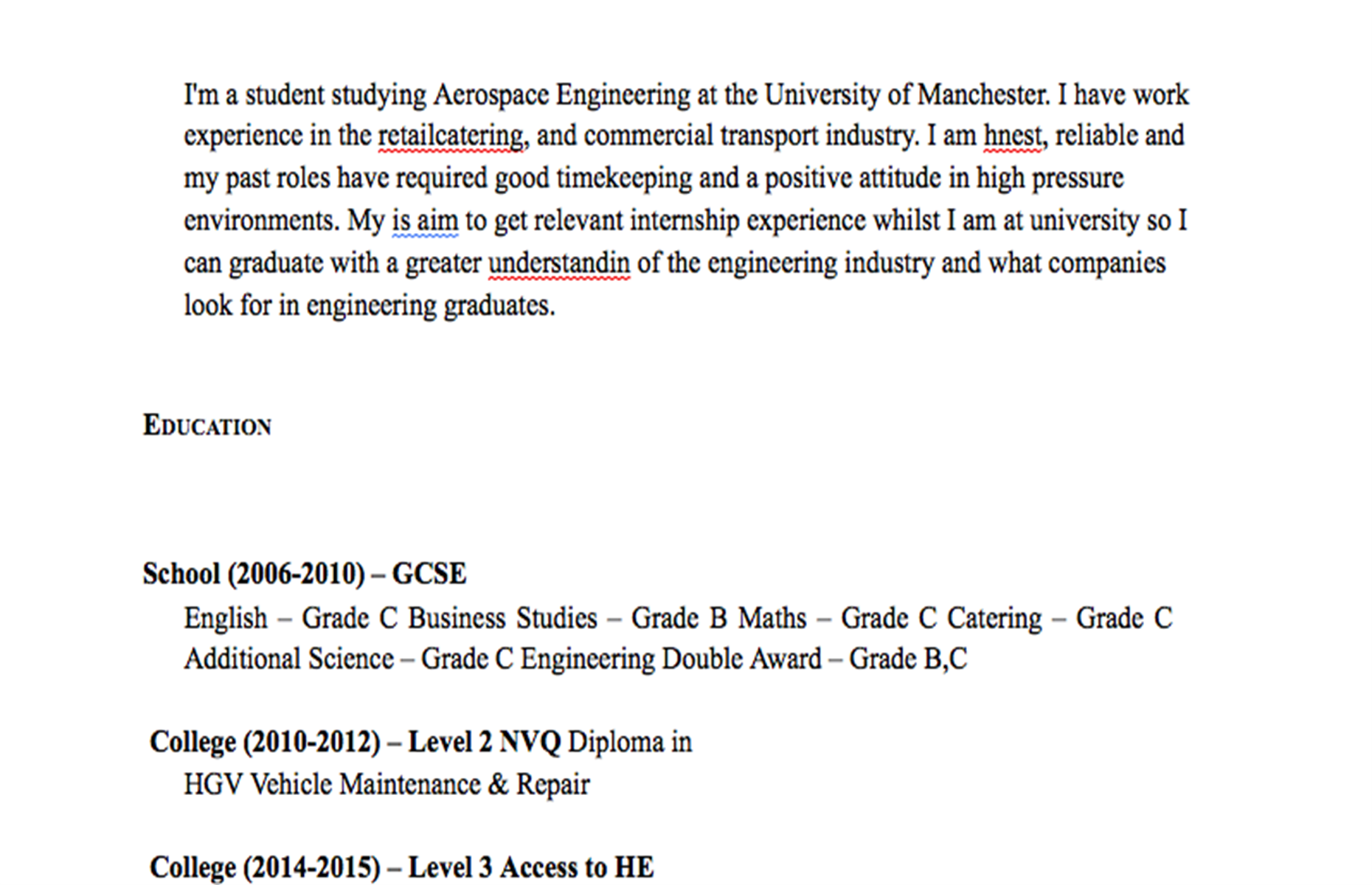
7. Errors and typos
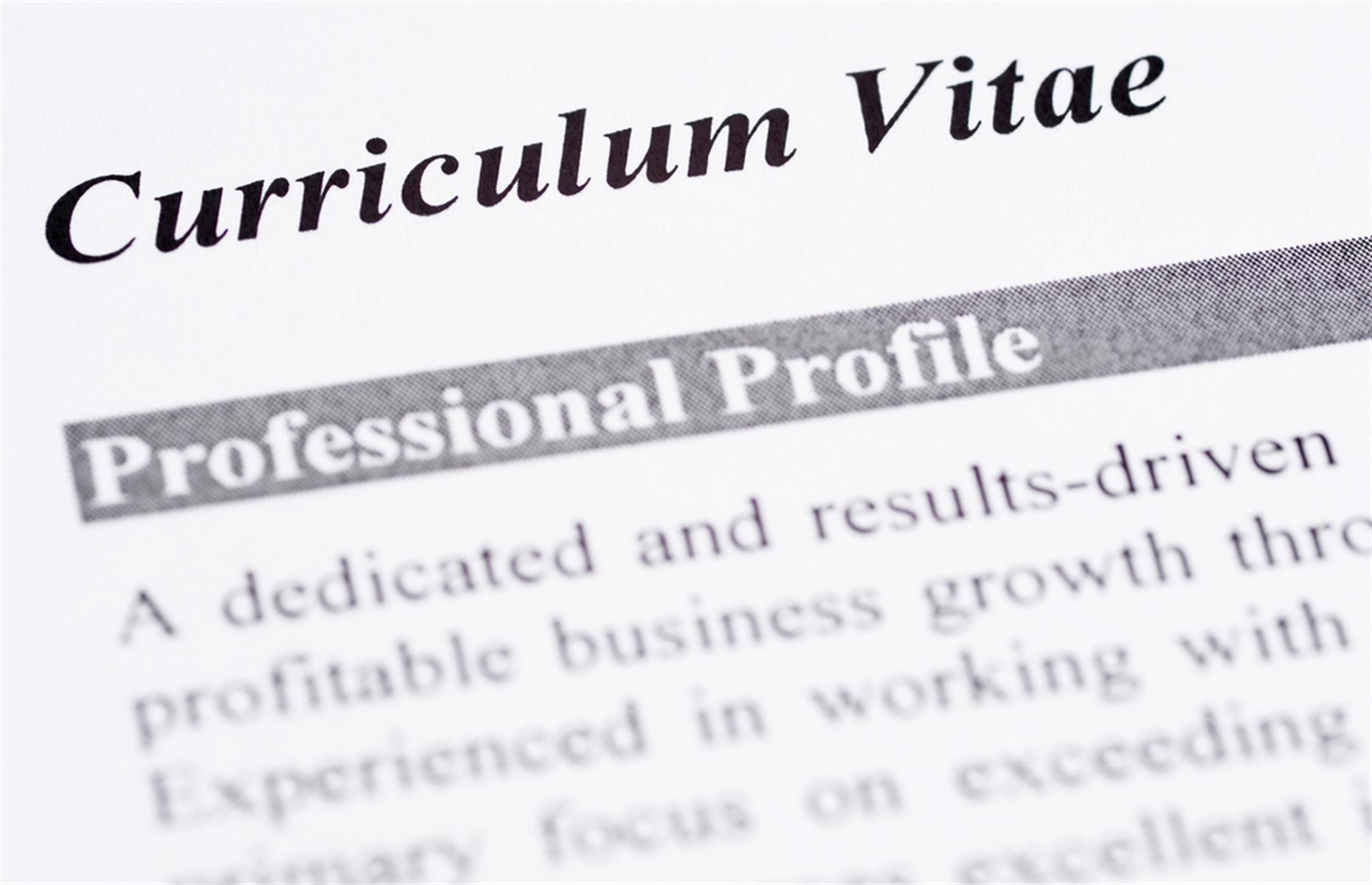
8. Not including a personal profile
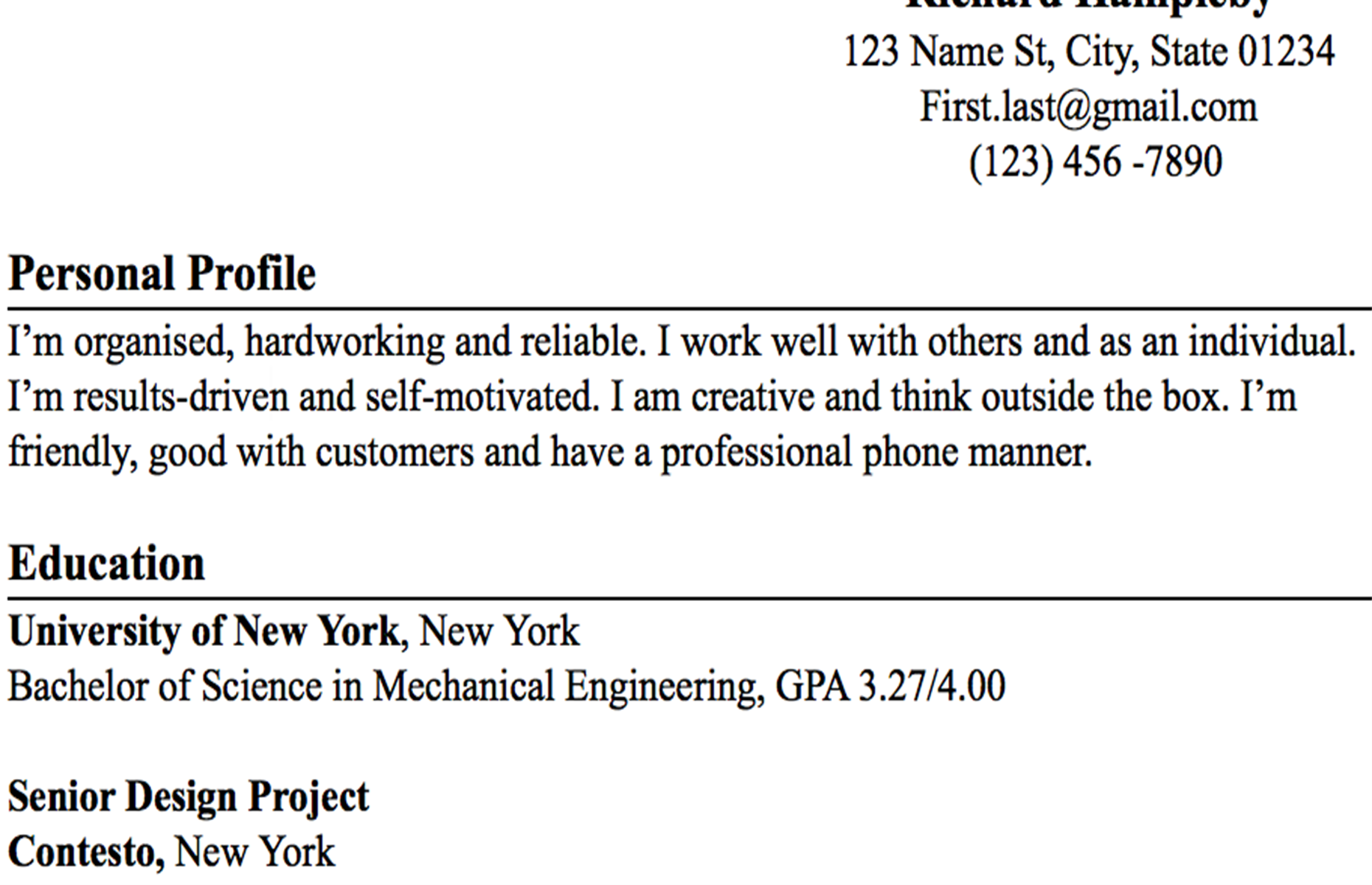
9. Including a generic personal profile
We've already established that including a personal summary is essential, but it's also important to think carefully about what to put in it. Of course, you want to sell yourself and make sure you show that you're a good fit for the role, but don't make it unoriginal. Try to avoid clichéd phrases that every other candidate will use such as 'self-motivated' and 'results-driven', and instead focus on being genuine and talking about what you can offer and what you're looking for.

10. Writing in the third person
Writing in the third person may seem like a creative way to make your résumé stand out, but it's not a good idea. Your résumé is your opportunity to communicate with potential employers, so writing it in the third person makes it hard to really connect with them. It can also give them the wrong impression of who you are as a person, as it can often come across as rather egotistical.
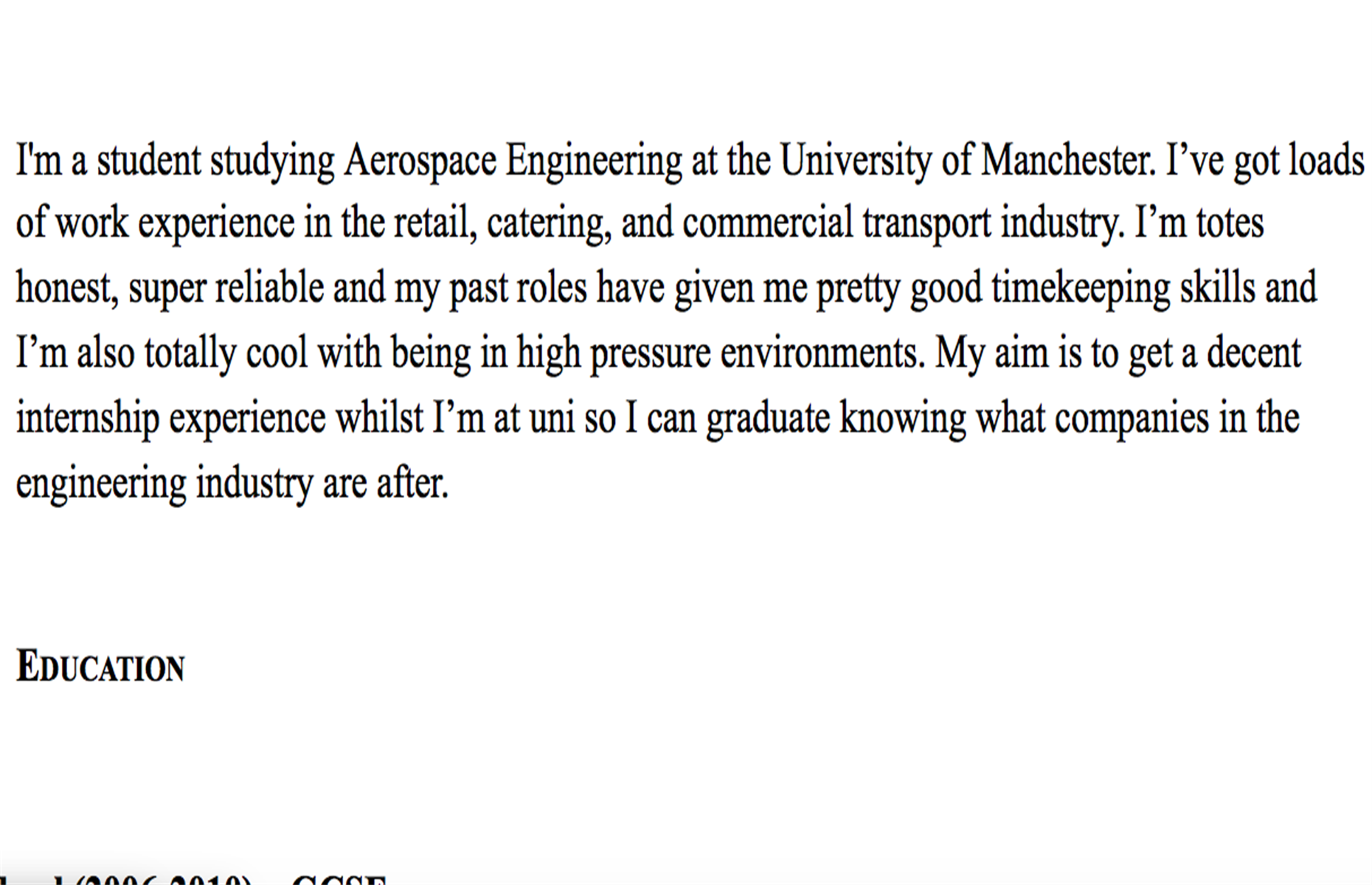
11. Poor choice of language
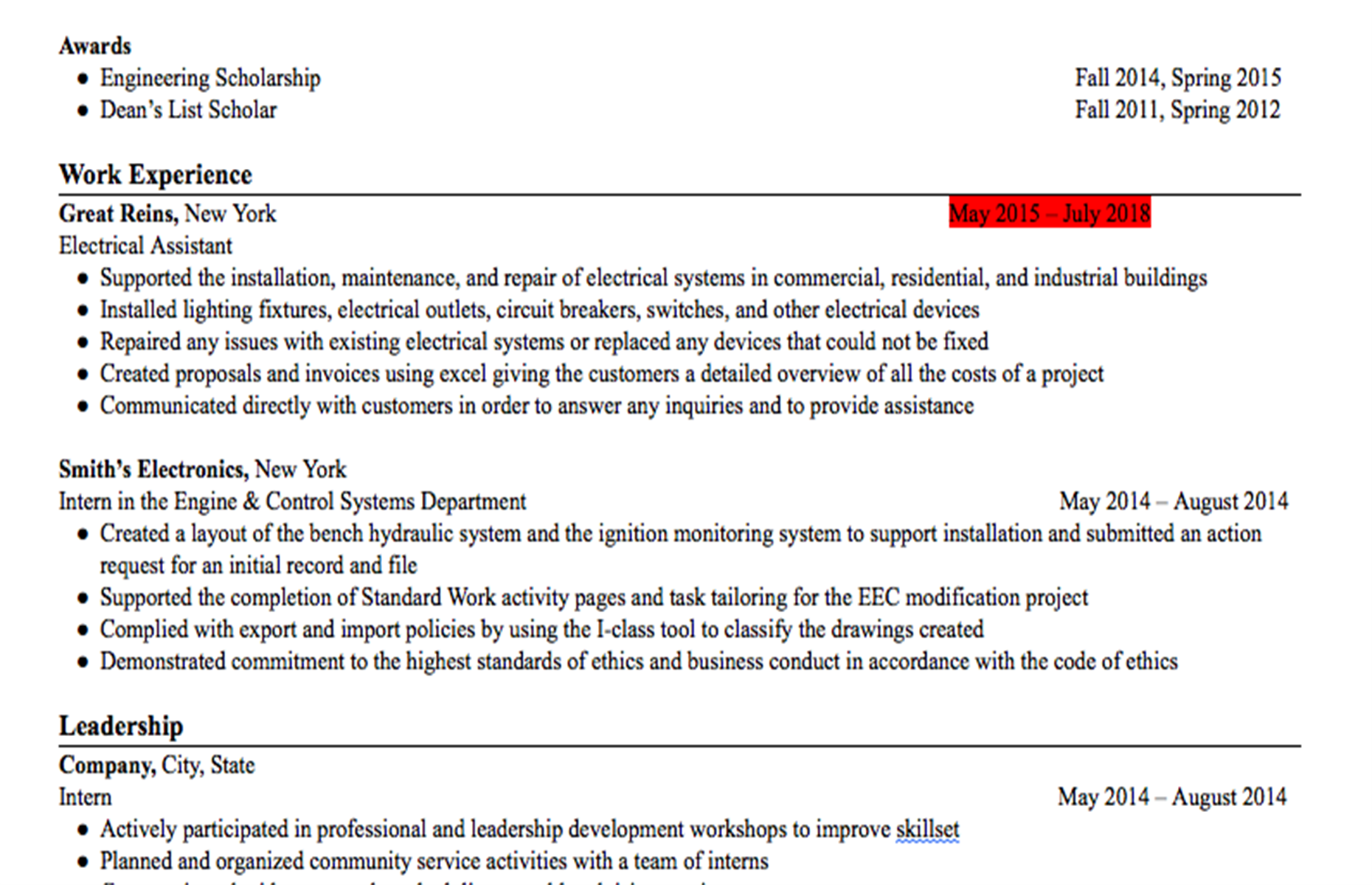
12. Outdated information
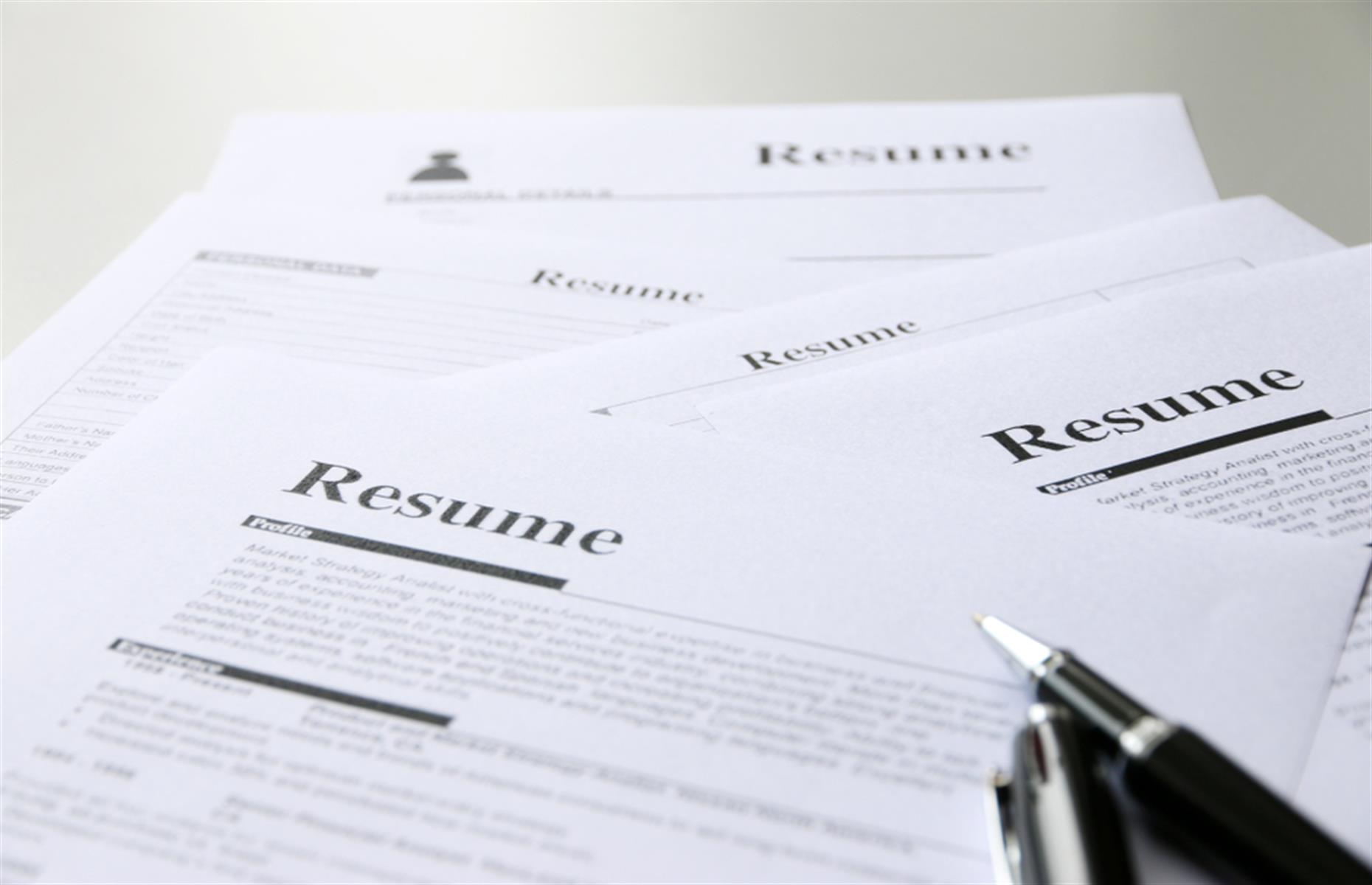
13. Not tailoring for each position
If you're applying for several jobs it might be tempting to just fire off the same résumé to all of them. However, it'll give you a much better chance of securing an interview if you customise it each time. Indeed, 63% of recruiters said this is something they definitely want from job candidates in a survey by Careerbuilder. Today, many companies perform an initial electronic review, so it's important to go through the job description and ensure you've included any keywords mentioned.

14. Telling lies
Three out of four recruiters have found a lie on a résumé, according to a study from CareerBuilder. The most frequent included lying about qualifications, job titles, and employment dates. However, while it may be common, it's definitely a mistake to avoid. Not only is it unethical, but if you get caught out it will undoubtedly hinder your chances of making it to interview. And if you were to get the position and the company finds out you weren't being truthful it could ultimately cost you your new job.

15. Exaggerating your skills

16. Not mentioning specific results

17. Including the wrong interests/hobbies
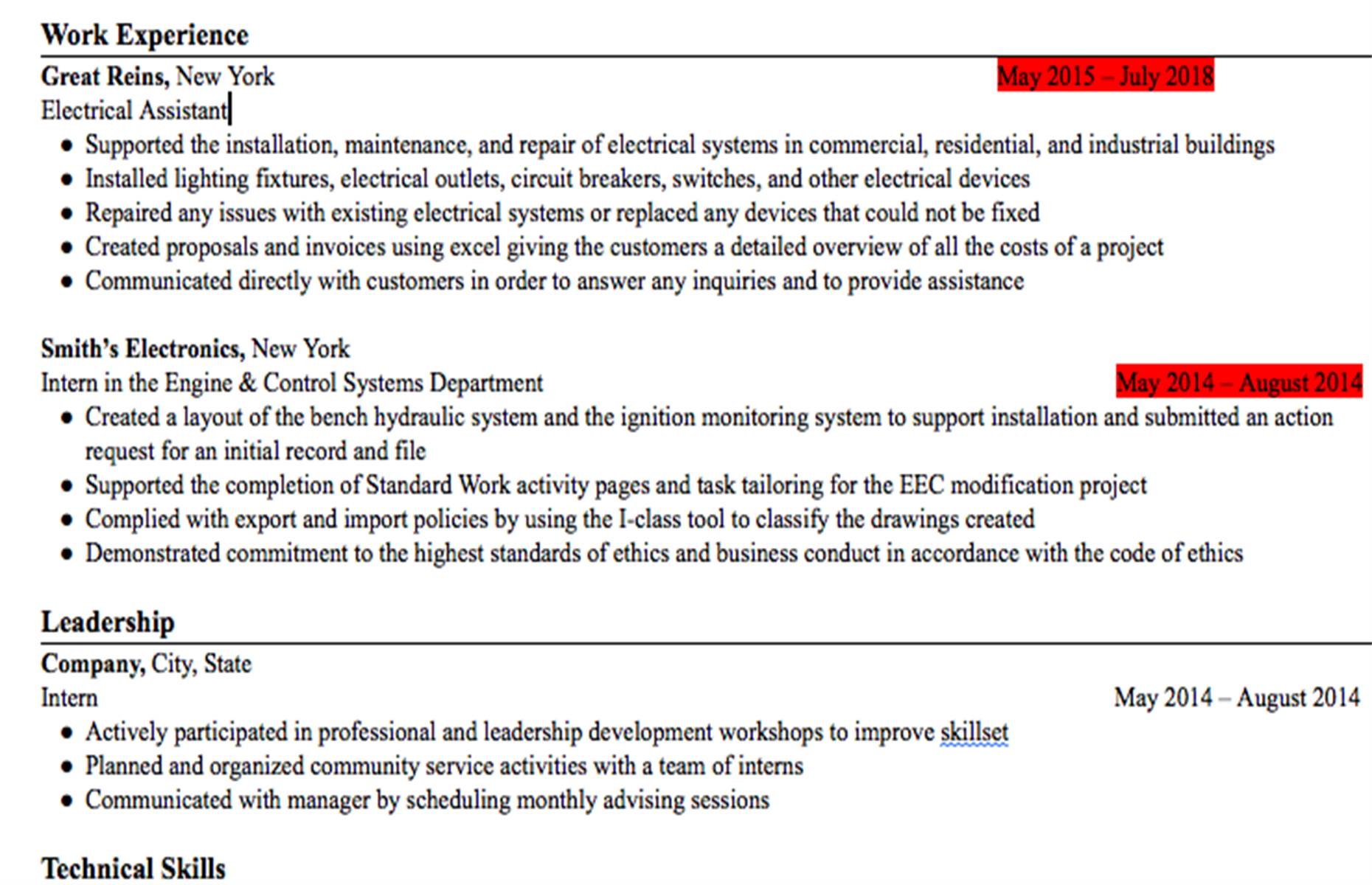
18. Not filling in gaps
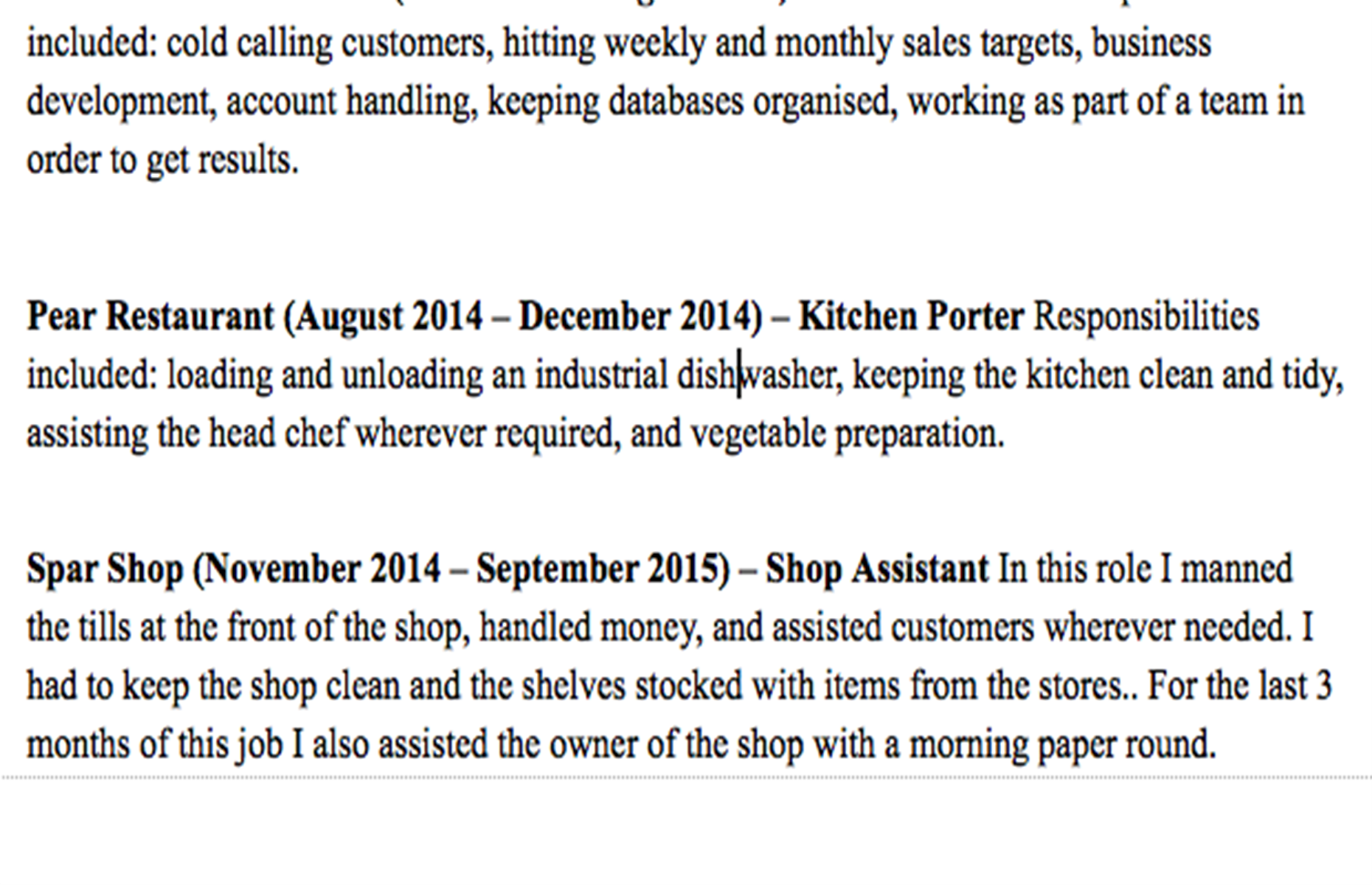
19. Leaving off helpful information
While you don't want to include a whole load of irrelevant information in your résumé, you also want to make sure you don't leave out anything that could potentially help with your application. Many people think it's not a good idea to add the jobs they had while at university, for example. However these types of jobs are often great for gaining soft skills such as teamwork and empathy, and a study by Wonderlic revealed that 93% of recruiters consider soft skills "essential" or "very important".

20. Making it too technical

21. Including a headshot
While including a headshot on your résumé is standard in some parts of the world such as the UAE, continental Europe and most of Asia, in other places it's not needed. In fact recruiters may well reject your application if it includes a photo. Unless you're an actor it's best to leave the headshot, it'll just make potential employers think you're egotistical or don't have a good grasp of workplace professionalism.
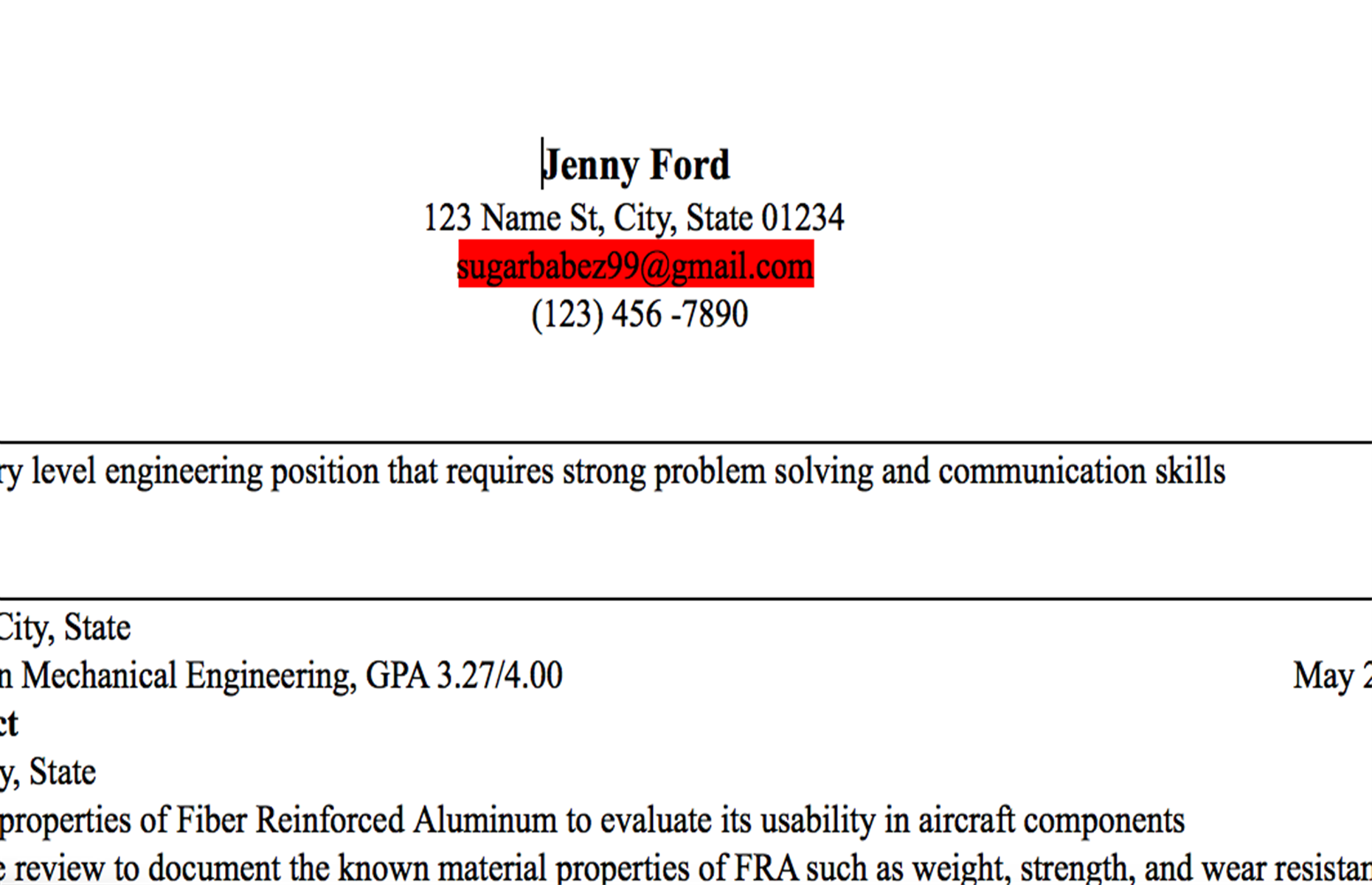
22. Using an unprofessional email address
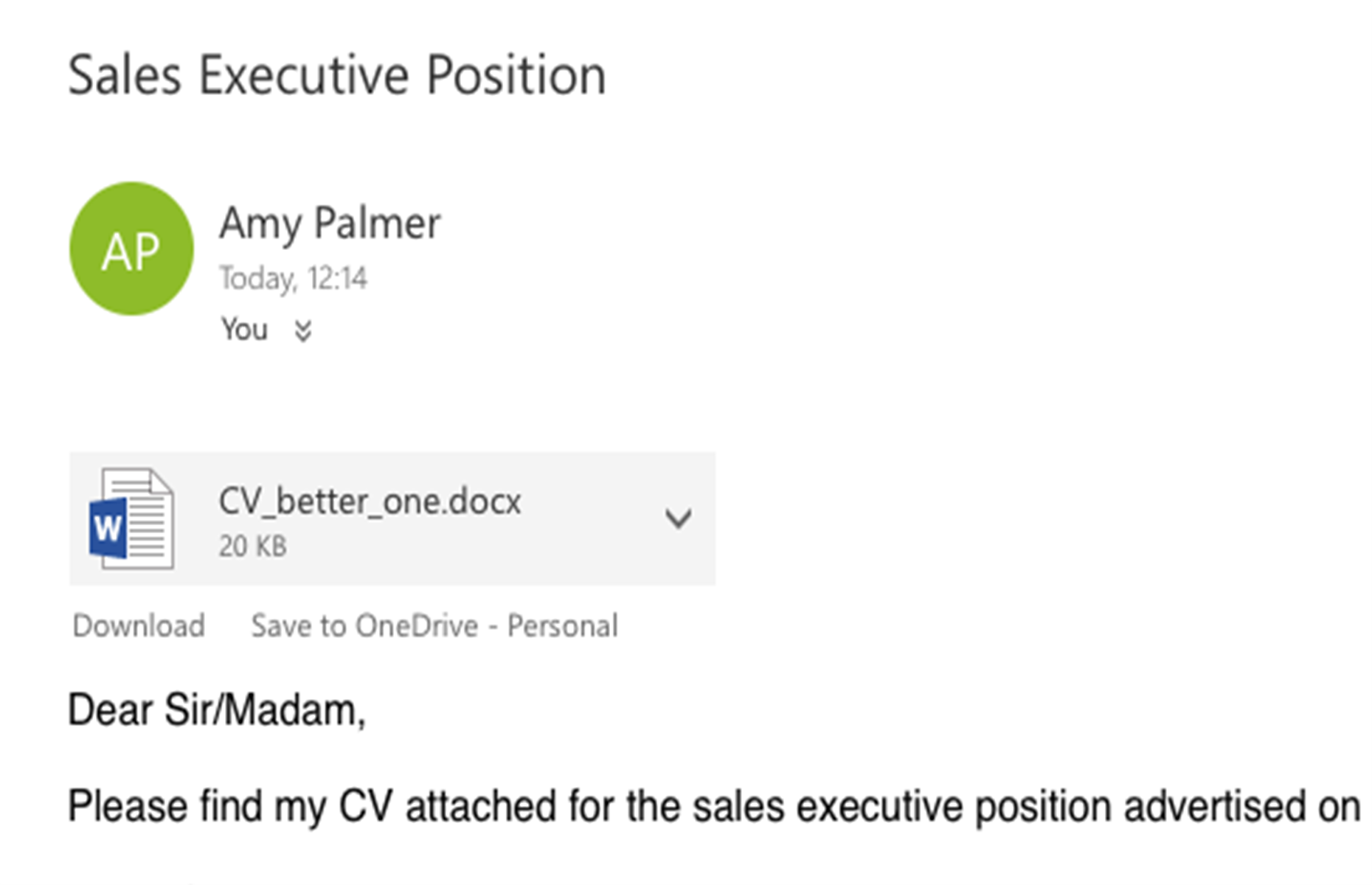
23. Poor choice of file name

24. Not being cautious with social media

25. Not sending a cover letter
While you should aim to make your résumé as complete as possible, you still need to add a cover letter for each application. It may seem like wasted effort, but avoiding it is definitely a mistake; 45% of recruiters will automatically discard an application if it doesn't come with a cover letter, according to Careerbuilder. Not only that, but it's your chance to go into more depth about your skills and experiences, and to show a little more of the 'real' you.
Now take a look at some online interview tips from an expert
Or discover jobs that no longer exist
More for You
If you sign and claim NHI Bill is good, then cancel your medical aid - Bosa’s Mmusi Maimane challenges Ramaphosa
Vladimir Putin keeps bombing his own citizens by mistake
30 delicious dinners that take less than 15 minutes to cook
Artist behind 'fiery' portrait of King says not everyone will like it
Here’s the African city ranked as the second-best city in the world in 2024
Global heating may drive deadly snakes to new regions, scientists warn
Elevate your lifestyle with the HUAWEI WATCH FIT 3: The ultimate fusion of fashion, health and performance
Russia lost a huge amount of troops in a single week
Cream cheese recalled nationwide over possible salmonella risk
The Best Movies of All Time
Dangerous migration jungle route from into US to be shut down
Brazil government announces Petrobras chief dismissed
Next Mfundo Vilakazi? Chiefs offer youngster new long-term deal!
This New e-Bike Has An Astonishing 90 Miles of Range
Karpowerships lost in the dark as Eskom keeps lights on
Temple of Protection: Goal is to usher in security and protection in a crime ridden society
Putin's latest nuclear show of strength to the West
Full list of foods recalled over outbreak of bacteria that can cause ‘flu-like symptoms’
White Noise: Neo-Nazi music festivals are on the rise in Europe
US consumer inflation eases slightly in April, in good news for Biden
Time in Elektrostal , Moscow Oblast, Russia now
- Tokyo 10:54PM
- Beijing 09:54PM
- Kyiv 04:54PM
- Paris 03:54PM
- London 02:54PM
- New York 09:54AM
- Los Angeles 06:54AM
Time zone info for Elektrostal
- The time in Elektrostal is 8 hours ahead of the time in New York when New York is on standard time, and 7 hours ahead of the time in New York when New York is on daylight saving time.
- Elektrostal does not change between summer time and winter time.
- The IANA time zone identifier for Elektrostal is Europe/Moscow.
Time difference from Elektrostal
Sunrise, sunset, day length and solar time for elektrostal.
- Sunrise: 04:11AM
- Sunset: 08:34PM
- Day length: 16h 23m
- Solar noon: 12:23PM
- The current local time in Elektrostal is 23 minutes ahead of apparent solar time.
Elektrostal on the map
- Location: Moscow Oblast, Russia
- Latitude: 55.79. Longitude: 38.46
- Population: 144,000
Best restaurants in Elektrostal
- #1 Tolsty medved - Steakhouses food
- #2 Ermitazh - European and japanese food
- #3 Pechka - European and french food
Find best places to eat in Elektrostal
- Best steak restaurants in Elektrostal
- Best bbqs in Elektrostal
- Best breakfast restaurants in Elektrostal
The 50 largest cities in Russia
- Yekaterinburg
- Novosibirsk
- Vladivostok

- Tours to Russia
- Practicalities
- Russia in Lists
Rusmania • Deep into Russia
Out of the Centre
Savvino-storozhevsky monastery and museum.

Zvenigorod's most famous sight is the Savvino-Storozhevsky Monastery, which was founded in 1398 by the monk Savva from the Troitse-Sergieva Lavra, at the invitation and with the support of Prince Yury Dmitrievich of Zvenigorod. Savva was later canonised as St Sabbas (Savva) of Storozhev. The monastery late flourished under the reign of Tsar Alexis, who chose the monastery as his family church and often went on pilgrimage there and made lots of donations to it. Most of the monastery’s buildings date from this time. The monastery is heavily fortified with thick walls and six towers, the most impressive of which is the Krasny Tower which also serves as the eastern entrance. The monastery was closed in 1918 and only reopened in 1995. In 1998 Patriarch Alexius II took part in a service to return the relics of St Sabbas to the monastery. Today the monastery has the status of a stauropegic monastery, which is second in status to a lavra. In addition to being a working monastery, it also holds the Zvenigorod Historical, Architectural and Art Museum.
Belfry and Neighbouring Churches

Located near the main entrance is the monastery's belfry which is perhaps the calling card of the monastery due to its uniqueness. It was built in the 1650s and the St Sergius of Radonezh’s Church was opened on the middle tier in the mid-17th century, although it was originally dedicated to the Trinity. The belfry's 35-tonne Great Bladgovestny Bell fell in 1941 and was only restored and returned in 2003. Attached to the belfry is a large refectory and the Transfiguration Church, both of which were built on the orders of Tsar Alexis in the 1650s.

To the left of the belfry is another, smaller, refectory which is attached to the Trinity Gate-Church, which was also constructed in the 1650s on the orders of Tsar Alexis who made it his own family church. The church is elaborately decorated with colourful trims and underneath the archway is a beautiful 19th century fresco.
Nativity of Virgin Mary Cathedral

The Nativity of Virgin Mary Cathedral is the oldest building in the monastery and among the oldest buildings in the Moscow Region. It was built between 1404 and 1405 during the lifetime of St Sabbas and using the funds of Prince Yury of Zvenigorod. The white-stone cathedral is a standard four-pillar design with a single golden dome. After the death of St Sabbas he was interred in the cathedral and a new altar dedicated to him was added.

Under the reign of Tsar Alexis the cathedral was decorated with frescoes by Stepan Ryazanets, some of which remain today. Tsar Alexis also presented the cathedral with a five-tier iconostasis, the top row of icons have been preserved.
Tsaritsa's Chambers

The Nativity of Virgin Mary Cathedral is located between the Tsaritsa's Chambers of the left and the Palace of Tsar Alexis on the right. The Tsaritsa's Chambers were built in the mid-17th century for the wife of Tsar Alexey - Tsaritsa Maria Ilinichna Miloskavskaya. The design of the building is influenced by the ancient Russian architectural style. Is prettier than the Tsar's chambers opposite, being red in colour with elaborately decorated window frames and entrance.

At present the Tsaritsa's Chambers houses the Zvenigorod Historical, Architectural and Art Museum. Among its displays is an accurate recreation of the interior of a noble lady's chambers including furniture, decorations and a decorated tiled oven, and an exhibition on the history of Zvenigorod and the monastery.
Palace of Tsar Alexis

The Palace of Tsar Alexis was built in the 1650s and is now one of the best surviving examples of non-religious architecture of that era. It was built especially for Tsar Alexis who often visited the monastery on religious pilgrimages. Its most striking feature is its pretty row of nine chimney spouts which resemble towers.

Plan your next trip to Russia
Ready-to-book tours.
Your holiday in Russia starts here. Choose and book your tour to Russia.
The Unique Burial of a Child of Early Scythian Time at the Cemetery of Saryg-Bulun (Tuva)
<< Previous page
Pages: 379-406
In 1988, the Tuvan Archaeological Expedition (led by M. E. Kilunovskaya and V. A. Semenov) discovered a unique burial of the early Iron Age at Saryg-Bulun in Central Tuva. There are two burial mounds of the Aldy-Bel culture dated by 7th century BC. Within the barrows, which adjoined one another, forming a figure-of-eight, there were discovered 7 burials, from which a representative collection of artifacts was recovered. Burial 5 was the most unique, it was found in a coffin made of a larch trunk, with a tightly closed lid. Due to the preservative properties of larch and lack of air access, the coffin contained a well-preserved mummy of a child with an accompanying set of grave goods. The interred individual retained the skin on his face and had a leather headdress painted with red pigment and a coat, sewn from jerboa fur. The coat was belted with a leather belt with bronze ornaments and buckles. Besides that, a leather quiver with arrows with the shafts decorated with painted ornaments, fully preserved battle pick and a bow were buried in the coffin. Unexpectedly, the full-genomic analysis, showed that the individual was female. This fact opens a new aspect in the study of the social history of the Scythian society and perhaps brings us back to the myth of the Amazons, discussed by Herodotus. Of course, this discovery is unique in its preservation for the Scythian culture of Tuva and requires careful study and conservation.
Keywords: Tuva, Early Iron Age, early Scythian period, Aldy-Bel culture, barrow, burial in the coffin, mummy, full genome sequencing, aDNA
Information about authors: Marina Kilunovskaya (Saint Petersburg, Russian Federation). Candidate of Historical Sciences. Institute for the History of Material Culture of the Russian Academy of Sciences. Dvortsovaya Emb., 18, Saint Petersburg, 191186, Russian Federation E-mail: [email protected] Vladimir Semenov (Saint Petersburg, Russian Federation). Candidate of Historical Sciences. Institute for the History of Material Culture of the Russian Academy of Sciences. Dvortsovaya Emb., 18, Saint Petersburg, 191186, Russian Federation E-mail: [email protected] Varvara Busova (Moscow, Russian Federation). (Saint Petersburg, Russian Federation). Institute for the History of Material Culture of the Russian Academy of Sciences. Dvortsovaya Emb., 18, Saint Petersburg, 191186, Russian Federation E-mail: [email protected] Kharis Mustafin (Moscow, Russian Federation). Candidate of Technical Sciences. Moscow Institute of Physics and Technology. Institutsky Lane, 9, Dolgoprudny, 141701, Moscow Oblast, Russian Federation E-mail: [email protected] Irina Alborova (Moscow, Russian Federation). Candidate of Biological Sciences. Moscow Institute of Physics and Technology. Institutsky Lane, 9, Dolgoprudny, 141701, Moscow Oblast, Russian Federation E-mail: [email protected] Alina Matzvai (Moscow, Russian Federation). Moscow Institute of Physics and Technology. Institutsky Lane, 9, Dolgoprudny, 141701, Moscow Oblast, Russian Federation E-mail: [email protected]
Shopping Cart Items: 0 Cart Total: 0,00 € place your order
Price pdf version
student - 2,75 € individual - 3,00 € institutional - 7,00 €

Copyright В© 1999-2022. Stratum Publishing House

IMAGES
VIDEO
COMMENTS
Learn the difference between hobbies and interests, and how to use them effectively on your resume. Find out the most common hobbies and interests for resumes in 2024, such as cooking, reading, volunteering, and more. See examples of how to list them in your resume with tips and templates.
Learn when and how to mention hobbies and interests on your resume, and which ones are the best for different jobs. Find out the difference between hobbies and interests, how to pick the right skills, and how to list them in a separate section. See 40+ examples of hobbies and interests for various fields and situations.
Learn when and how to add hobbies and interests to your resume, and what types of hobbies and interests are most relevant and valuable for employers. See examples of hobbies and interests for different jobs and situations, and tips for writing about them effectively.
Learn how to choose and write about hobbies and interests that can showcase your skills and qualities to employers. Browse 135 examples of hobbies by category, from creative arts to sports.
Learn when to include hobbies and interests on your resume and how to do it right. Find out the difference between hobbies and interests, the top examples, and the best way to format them.
Learn how to choose and list hobbies and interests on your resume that showcase your skills and fit the company culture. Find out when and how to avoid including hobbies and interests that may be inappropriate or irrelevant.
Learn how to choose and showcase hobbies and interests on your resume that align with the job requirements and the company culture. Find examples of good and bad hobbies for different types of jobs and industries.
Learn the benefits and drawbacks of adding hobbies and interests on your resume, and how to do it effectively. Find out the difference between hobbies and interests, and see examples of both.
Example of a resume with interests and hobbies Here is an example of what a resume with interests and hobbies listed might look like. John Smith New York City, New York (123) 456-7891 [email protected] Summary Talented and motivated sales associate with six years of experience. Achieved 40% increase in sales during the past year.
Here's how you can add your hobbies and interests to a resume: 1. First, think about what you do in your free time. Consider anything you enjoy doing when you're not working, like exercising, reading, cooking or anything else. Most things that you like doing in your free time can be considered hobbies or interests. 2.
Learn when and how to professionally list your hobbies on your resume, and how they can show your skills and interests. Find out what hobbies to include, avoid, and customize for different companies and positions. See examples of hobbies for various fields and industries.
Learn when and how to include a hobbies section on your resume to showcase your personality, interests, and skills. Find out what kinds of hobbies are best for different roles and how to format them.
Learn when and how to list your hobbies and interests on your resume or CV to stand out from other candidates. Find out the best hobbies and interests for different jobs and industries, and get tips on writing them effectively.
Learn when and how to add hobbies and interests to your resume to impress employers and show your value. Find out which hobbies and interests are relevant, beneficial, or risky for different jobs and industries.
The hobbies section should be clearly titled to ensure it is not encompassed with volunteer work, honors and awards or another of the optional resume sections. It could be simply named ' Personal Interests ' or could include other important facts or certificates that you are relevant to your job application under the heading ...
Learn how to list hobbies and interests on your resume to showcase your personality, creativity, and skills. Find 150+ examples of hobbies and interests categorized by type and relevance to different jobs.
There are certain hobbies and interests that you should leave off your resume, including: Joke hobbies, e.g., "Being awesome" or "Making my mom proud.". Anything seen as illegal or illicit, such as "partying" or "street art.". Hobbies that are physically aggressive or dangerous, like "kickboxing" and "daredevil tricks.".
Skills demonstrated with arts: Project management, leadership, planning, attention to detail. Examples of art interests/hobbies: Chess, Broadway, theater, music, reading, writing, photography, design. Examples of how to list arts on your resume: Attend a weekly art program, which benefits the local community schools.
Learn when and how to list your hobbies and interests on your résumé to showcase your personality and skills. Find 200 suggestions for hobbies and interests for different career paths and situations.
Add any experiences that you believe will help showcase you as a professional. Athletics or other non-industry organizations can be added; however, be sure to prioritize industry-related content on your resume. Do not add hobbies unless you are affiliated with an organization (for instance, a UTD Baking Club would be all right to list.
Decide on a CV format and style. Before you start writing your CV, you need to format it properly. Open a new document in Microsoft Word or Google Docs and use the following settings: Set ½ - 1" margins on each side. Use a font size between 10 and 12 points. Select a professional font such as Times New Roman or Arial.
loveMONEY. 6. Bad use of colour. Adding a splash of colour to your résumé won't hurt if you're applying to jobs in the creative sector or less conventional companies. However, you should be ...
Sunrise, sunset, day length and solar time for Elektrostal. Sunrise: 04:25AM. Sunset: 08:21PM. Day length: 15h 56m. Solar noon: 12:23PM. The current local time in Elektrostal is 23 minutes ahead of apparent solar time.
Zvenigorod's most famous sight is the Savvino-Storozhevsky Monastery, which was founded in 1398 by the monk Savva from the Troitse-Sergieva Lavra, at the invitation and with the support of Prince Yury Dmitrievich of Zvenigorod. Savva was later canonised as St Sabbas (Savva) of Storozhev. The monastery late flourished under the reign of Tsar ...
GENERAL AFFIDAVIT Russian Federation..... ) Moscow Oblast ..... ) City of Moscow.....
Burial 5 was the most unique, it was found in a coffin made of a larch trunk, with a tightly closed lid. Due to the preservative properties of larch and lack of air access, the coffin contained a well-preserved mummy of a child with an accompanying set of grave goods. The interred individual retained the skin on his face and had a leather ...